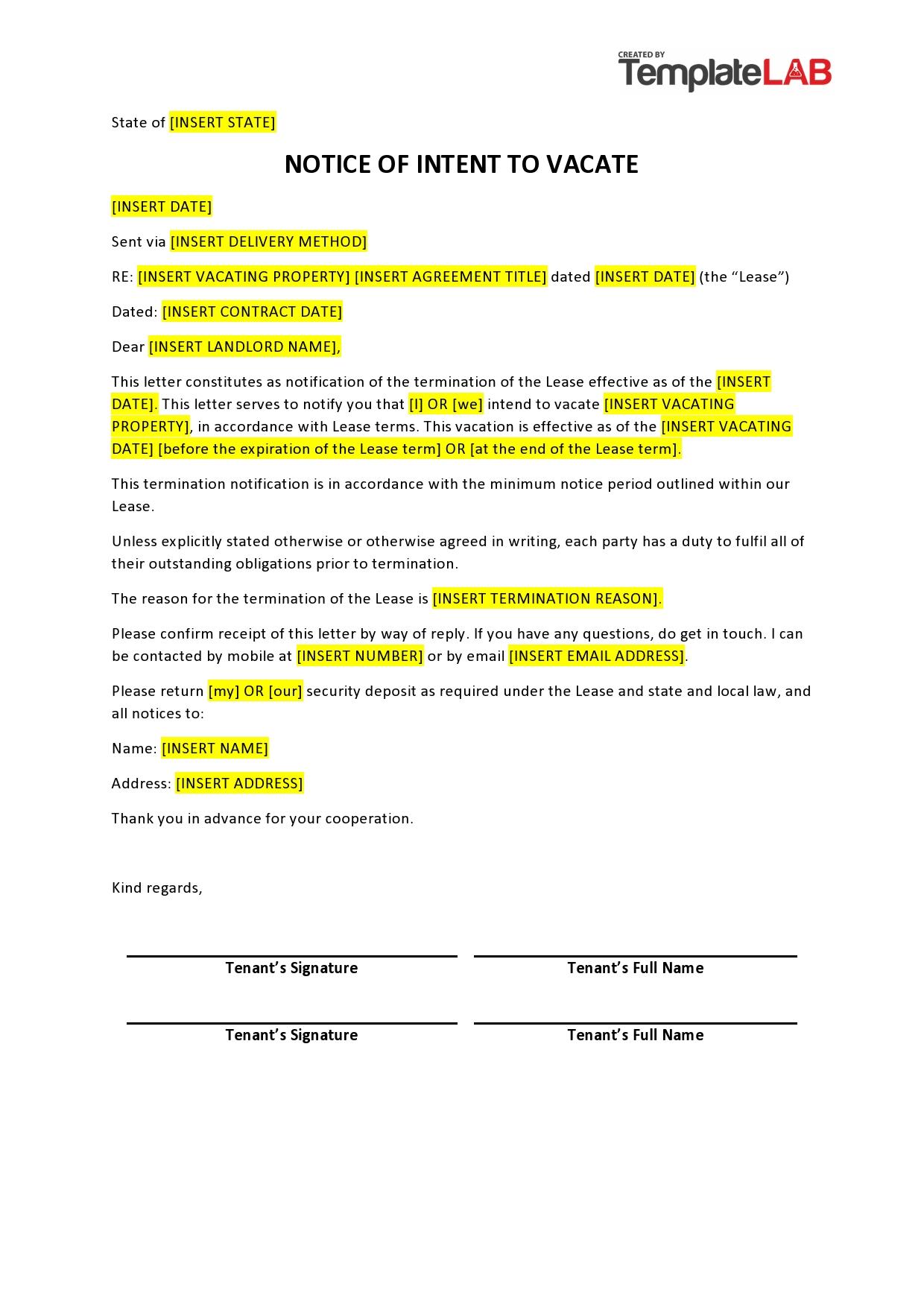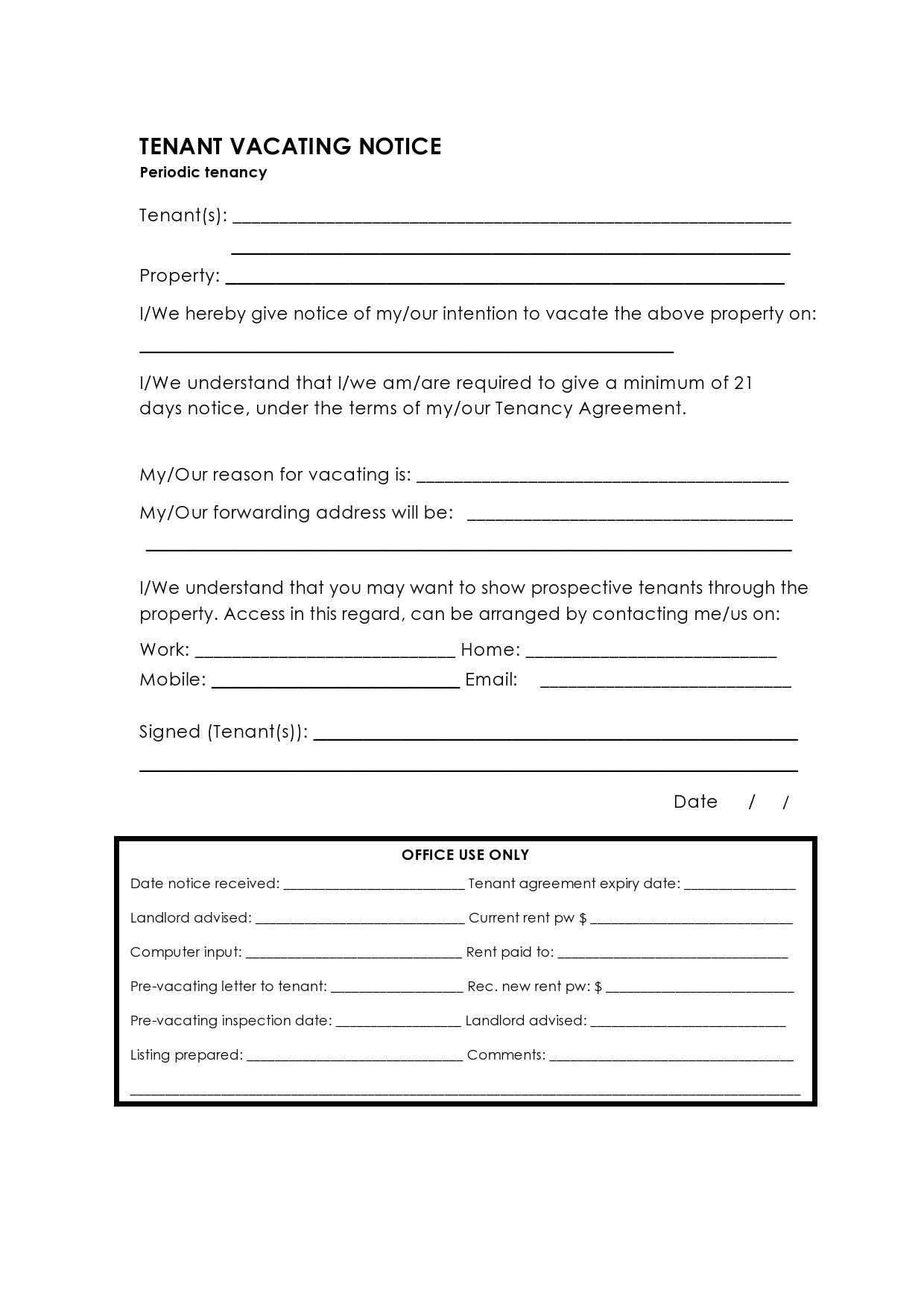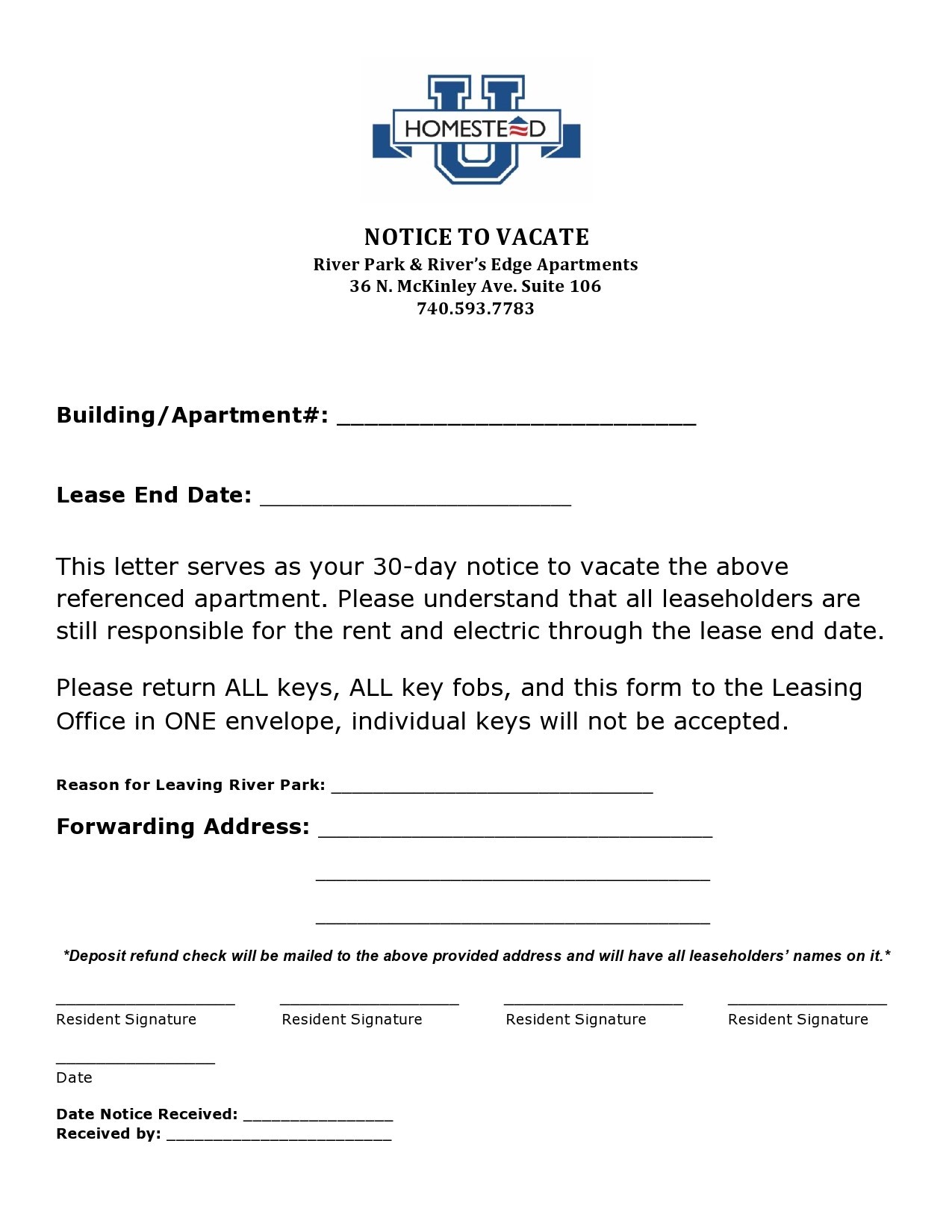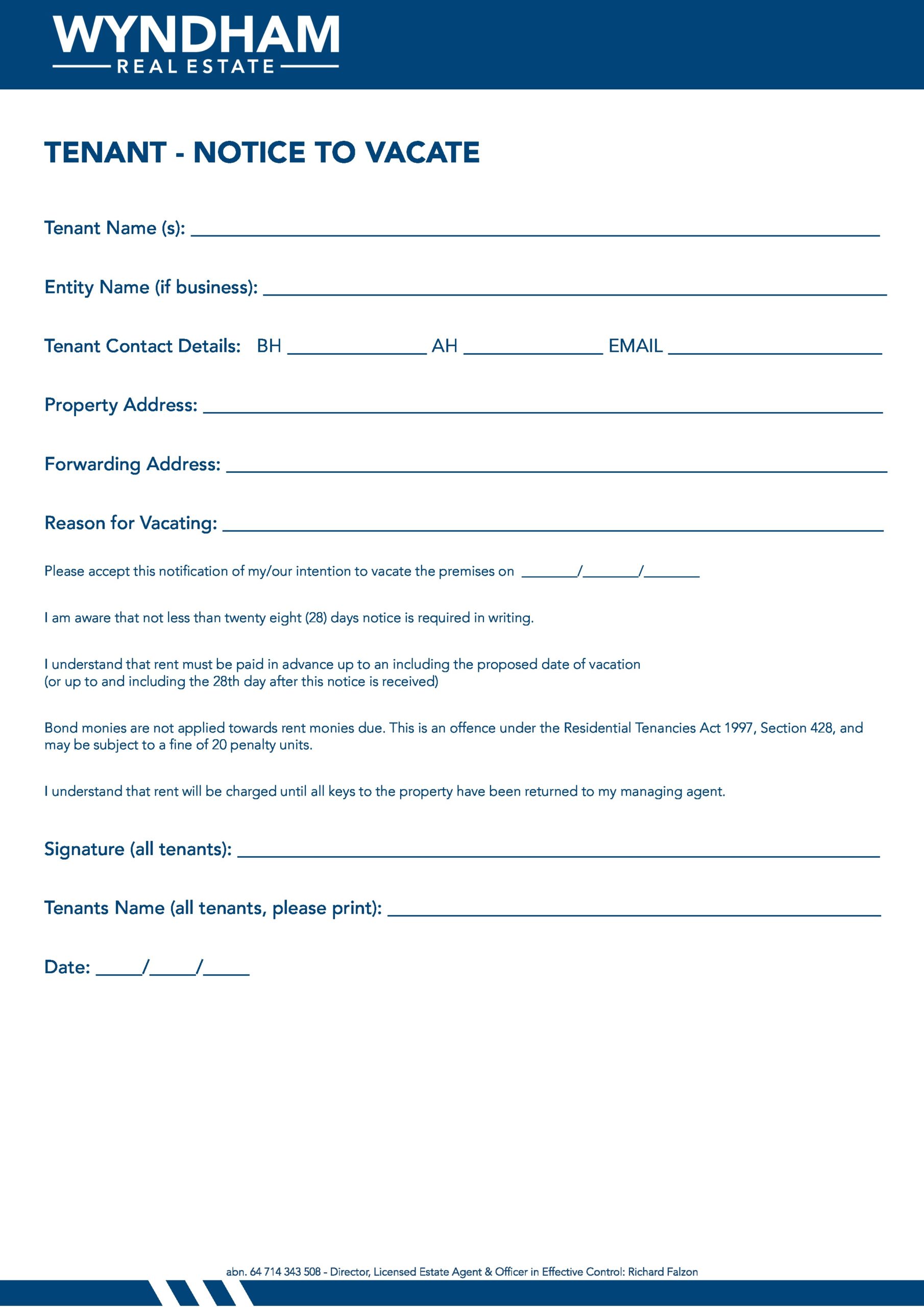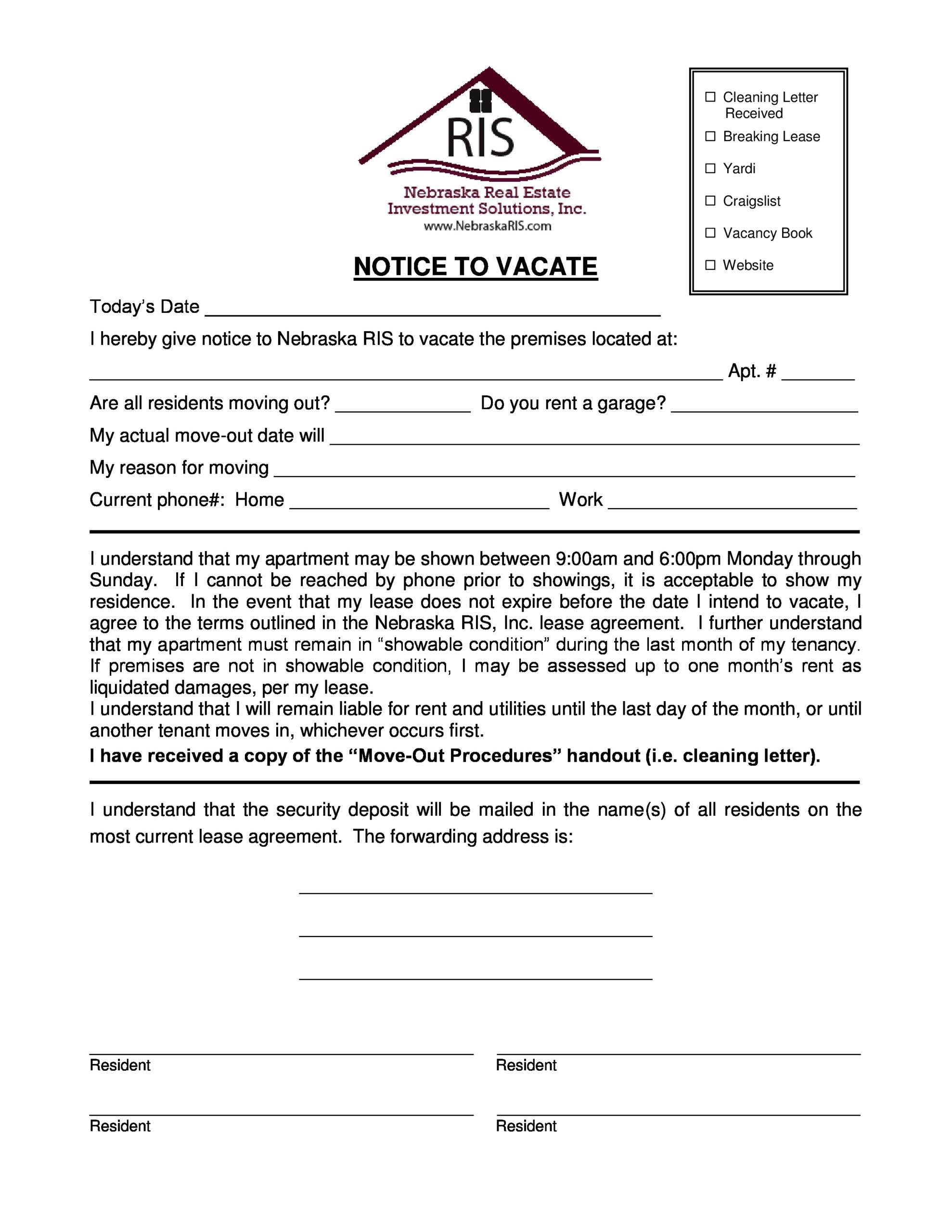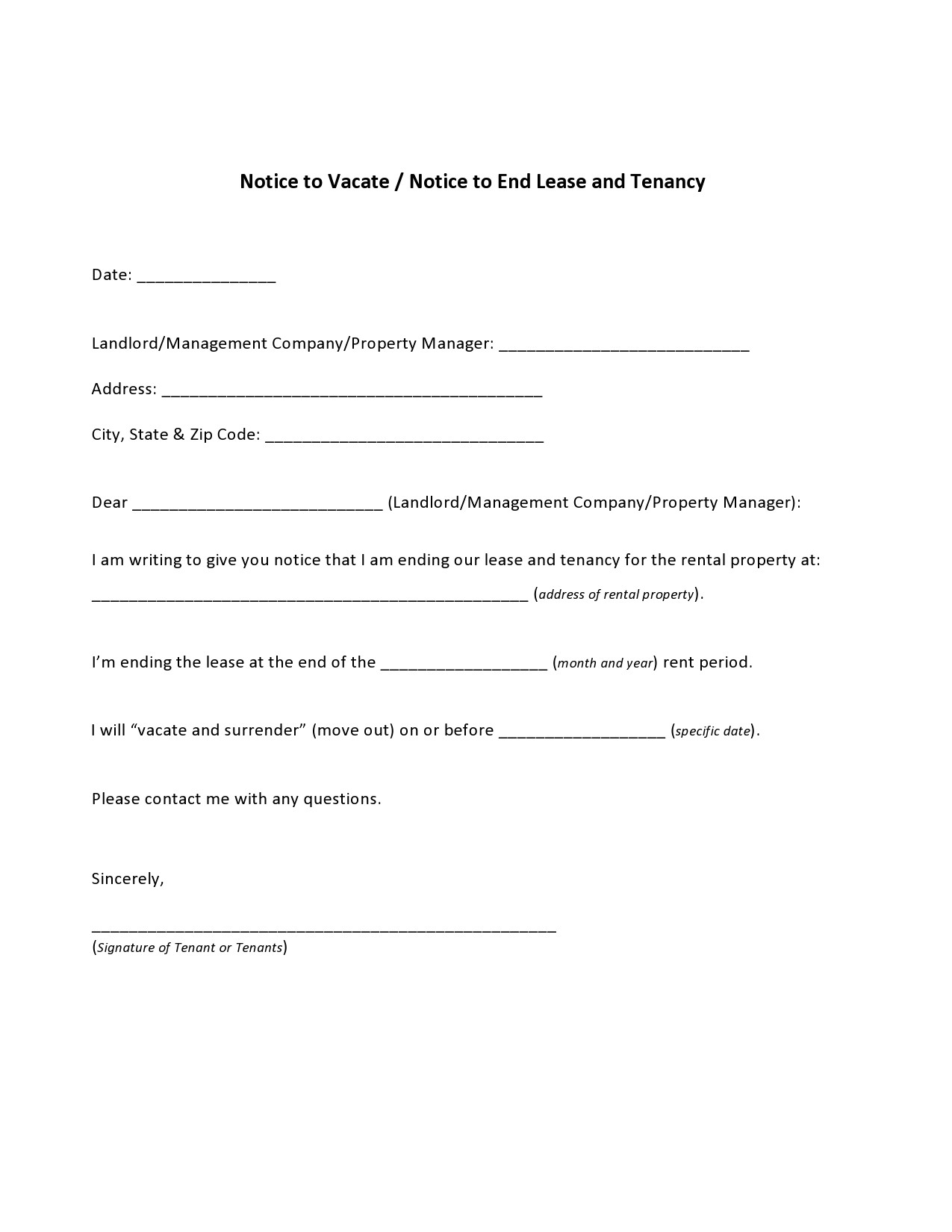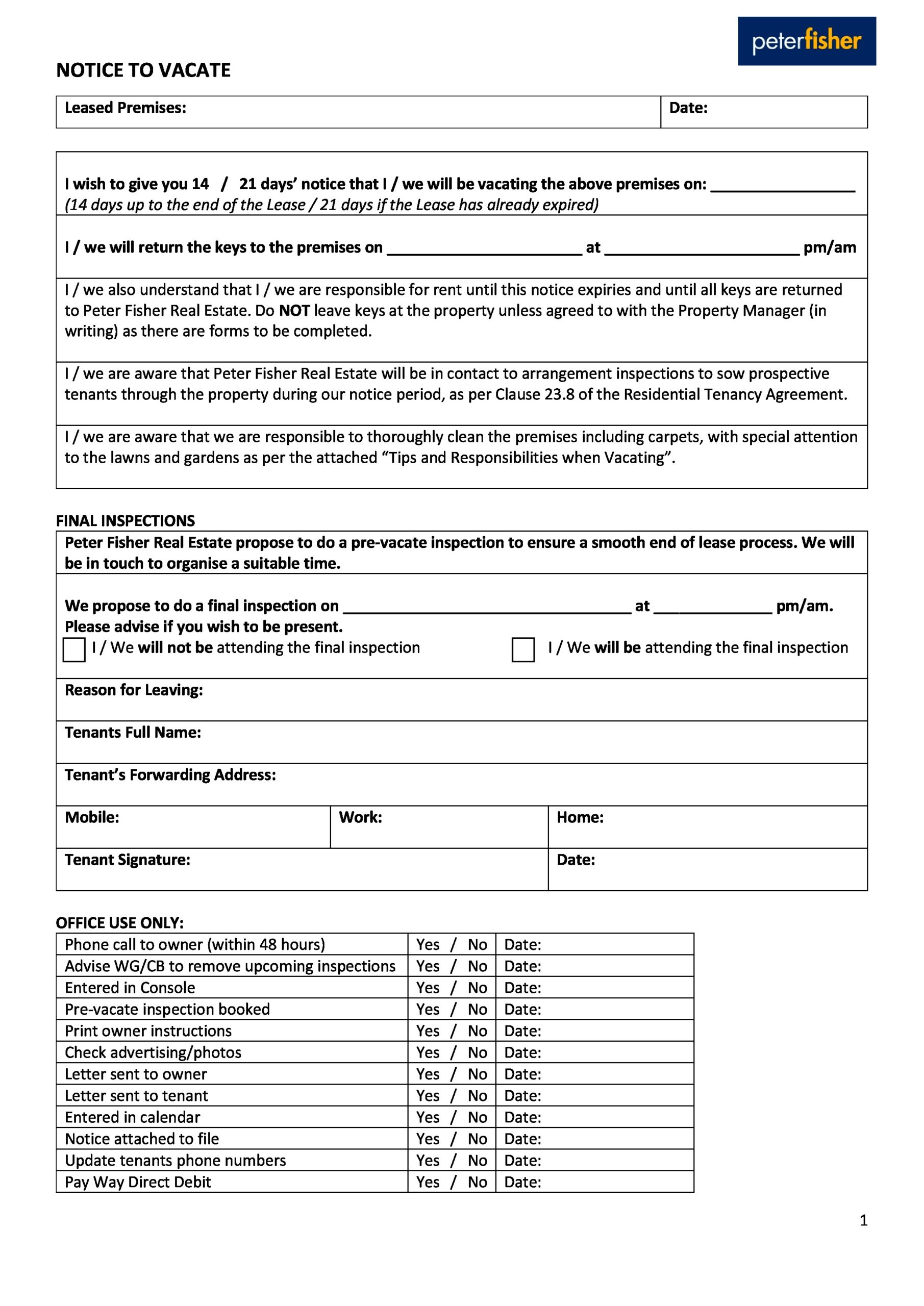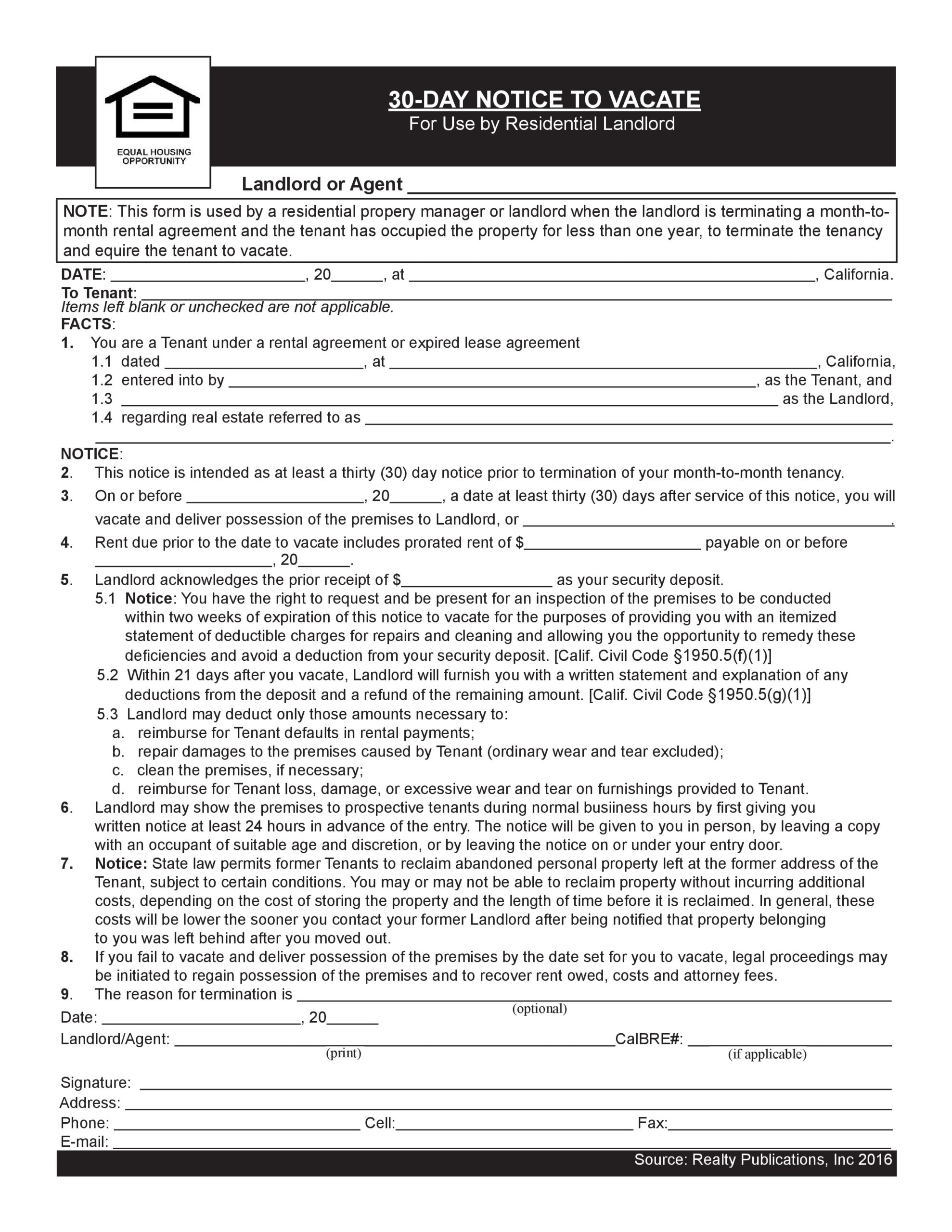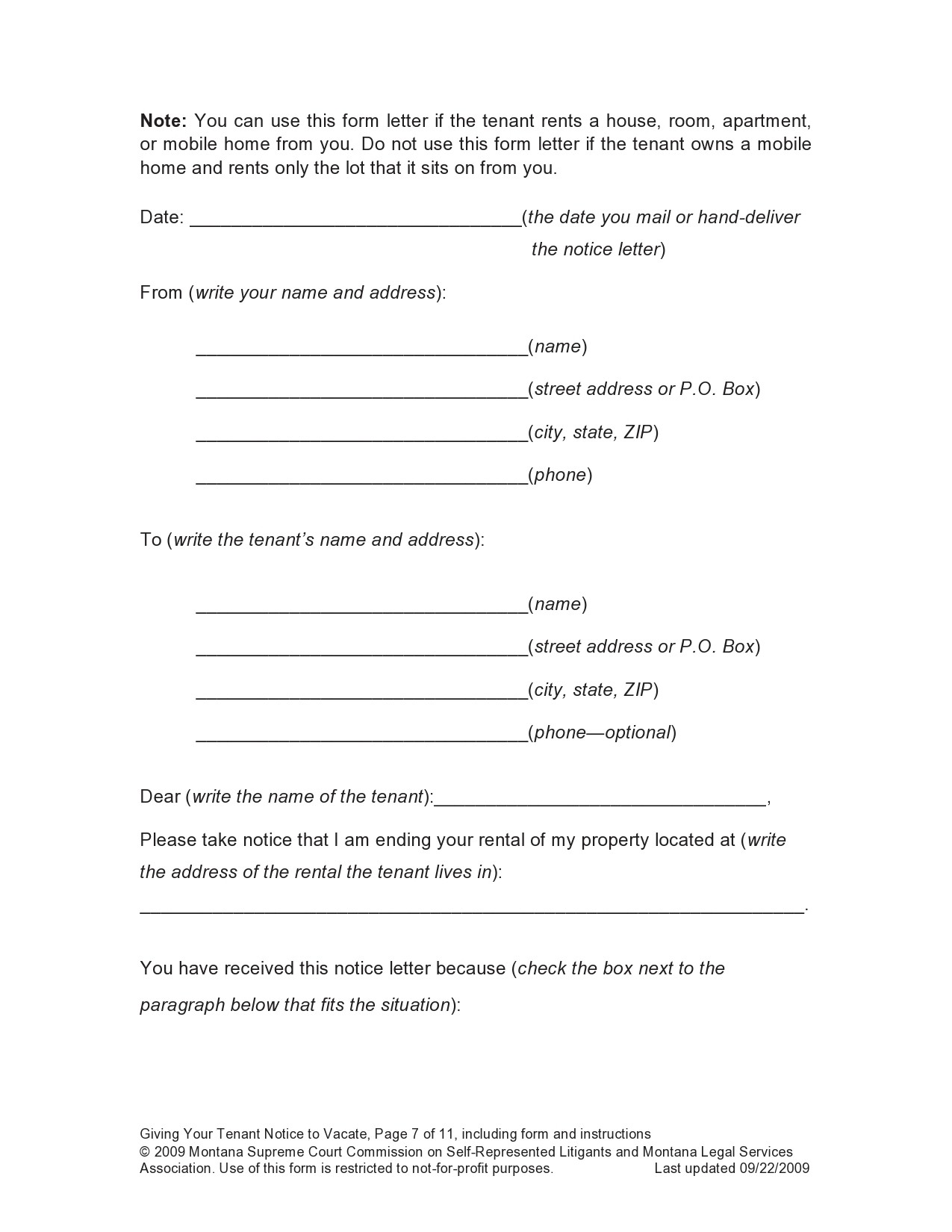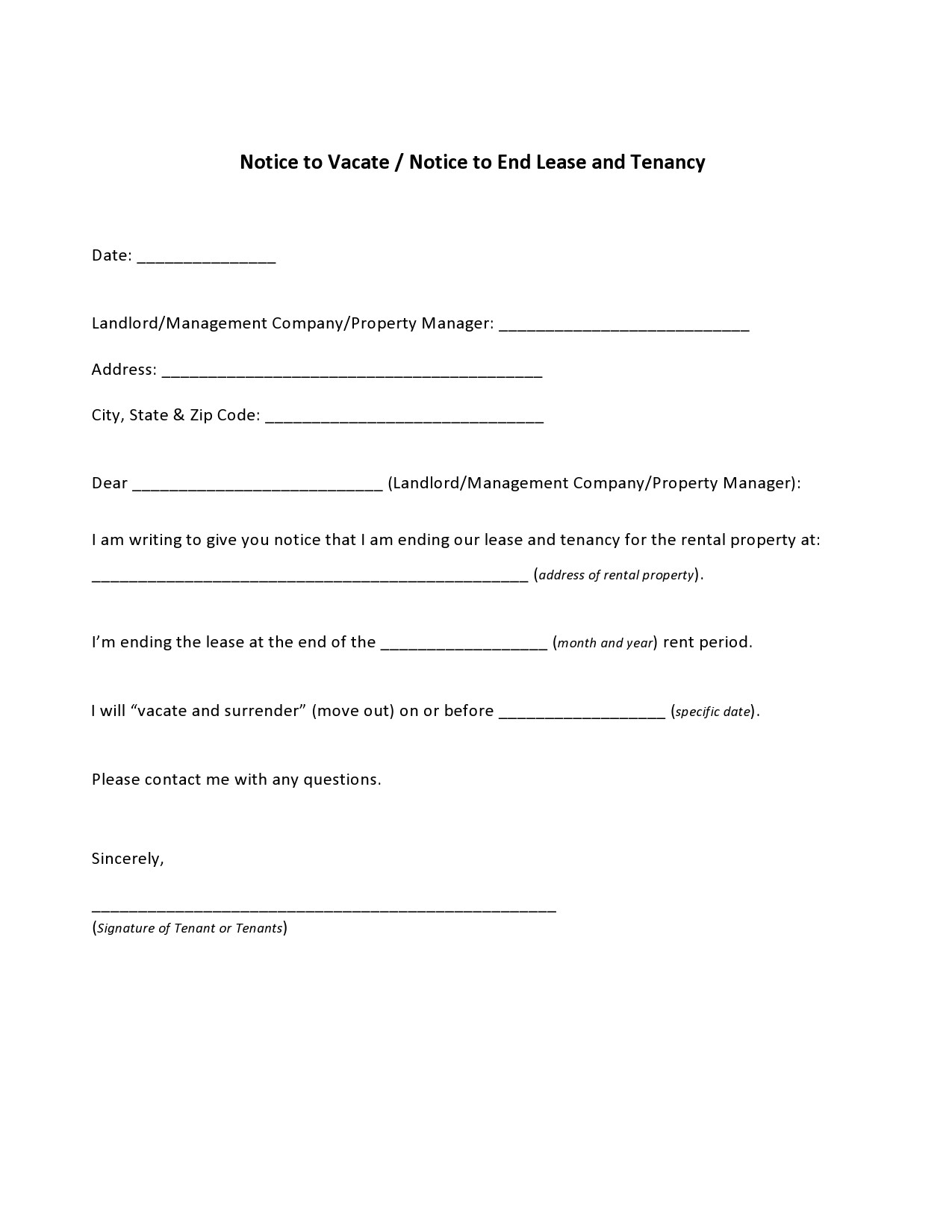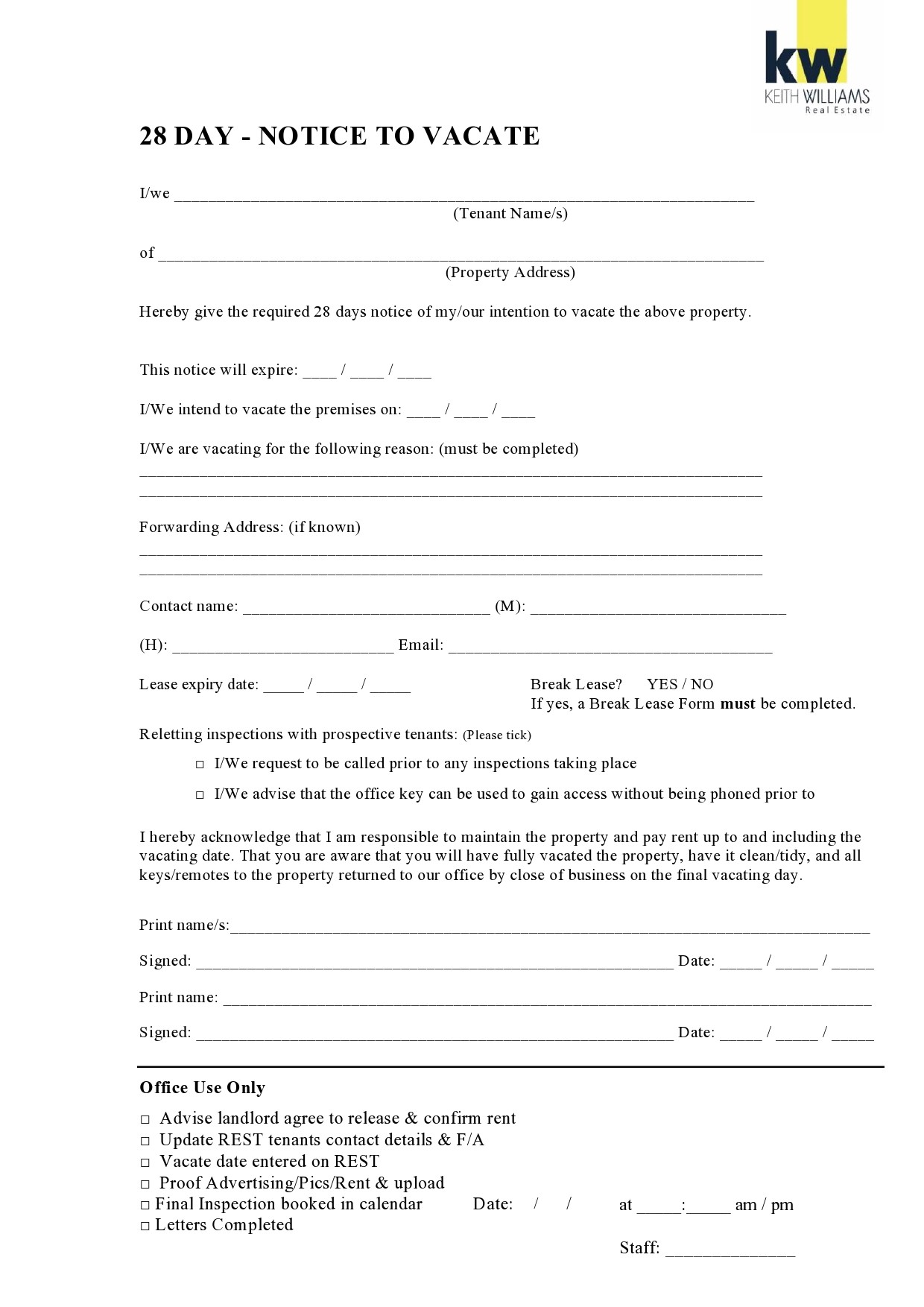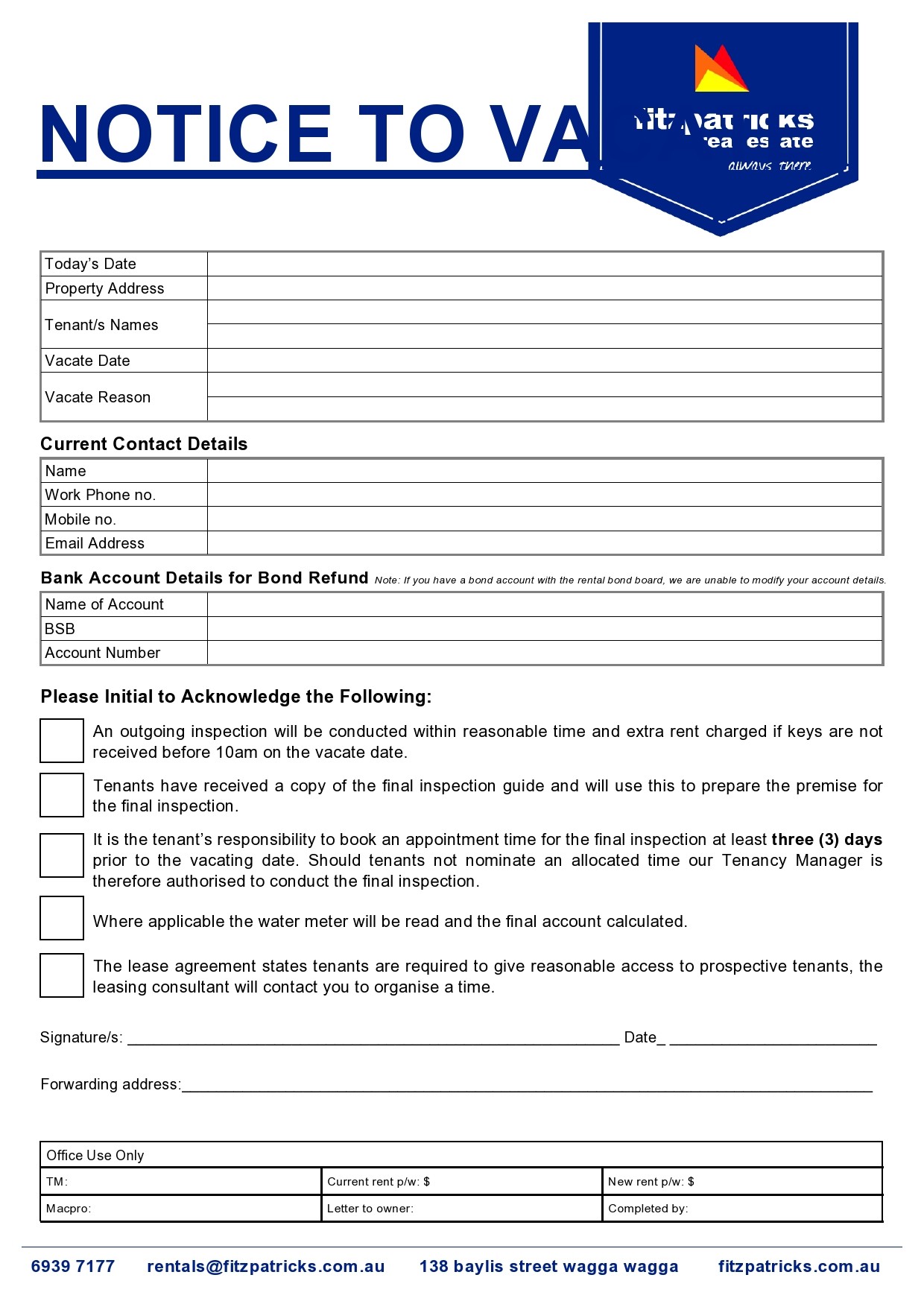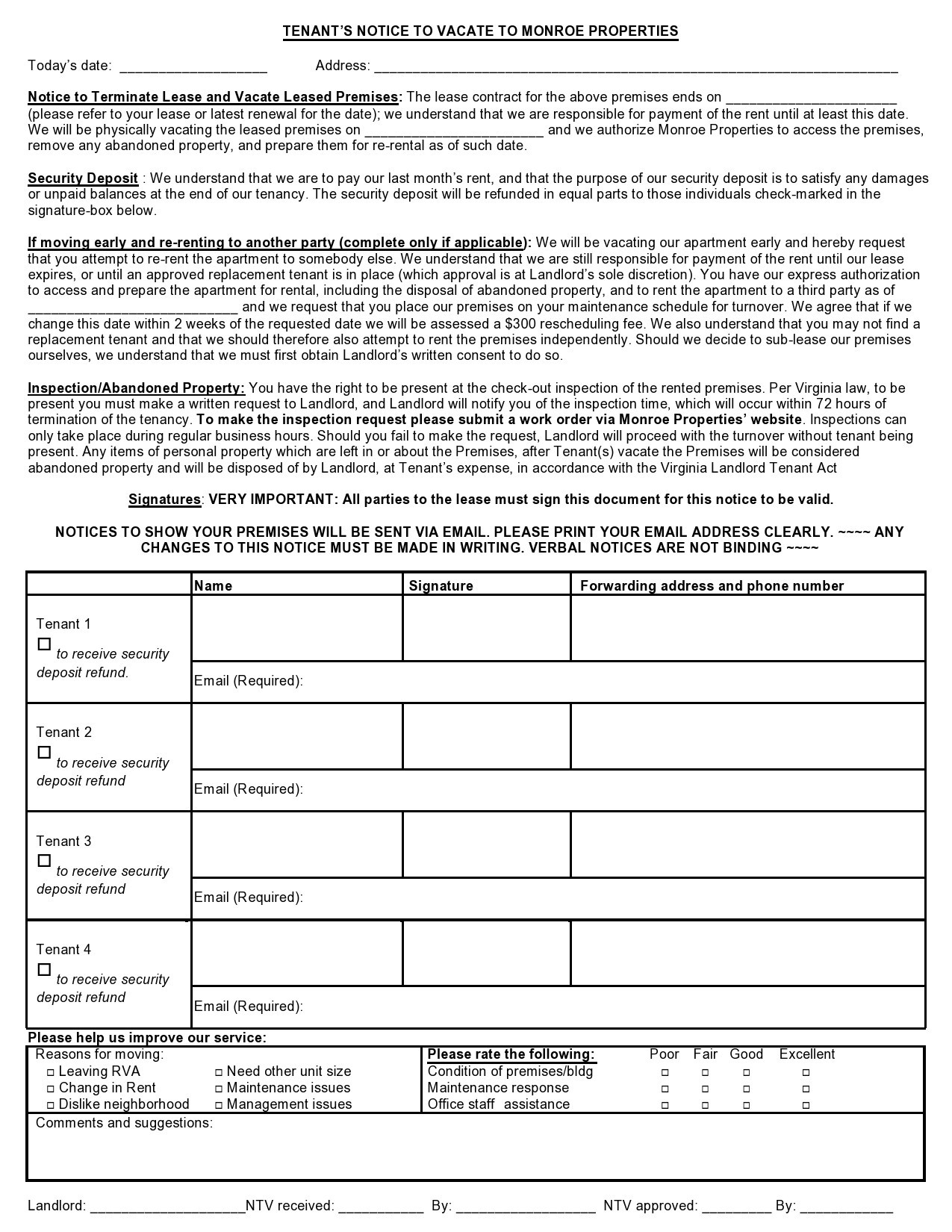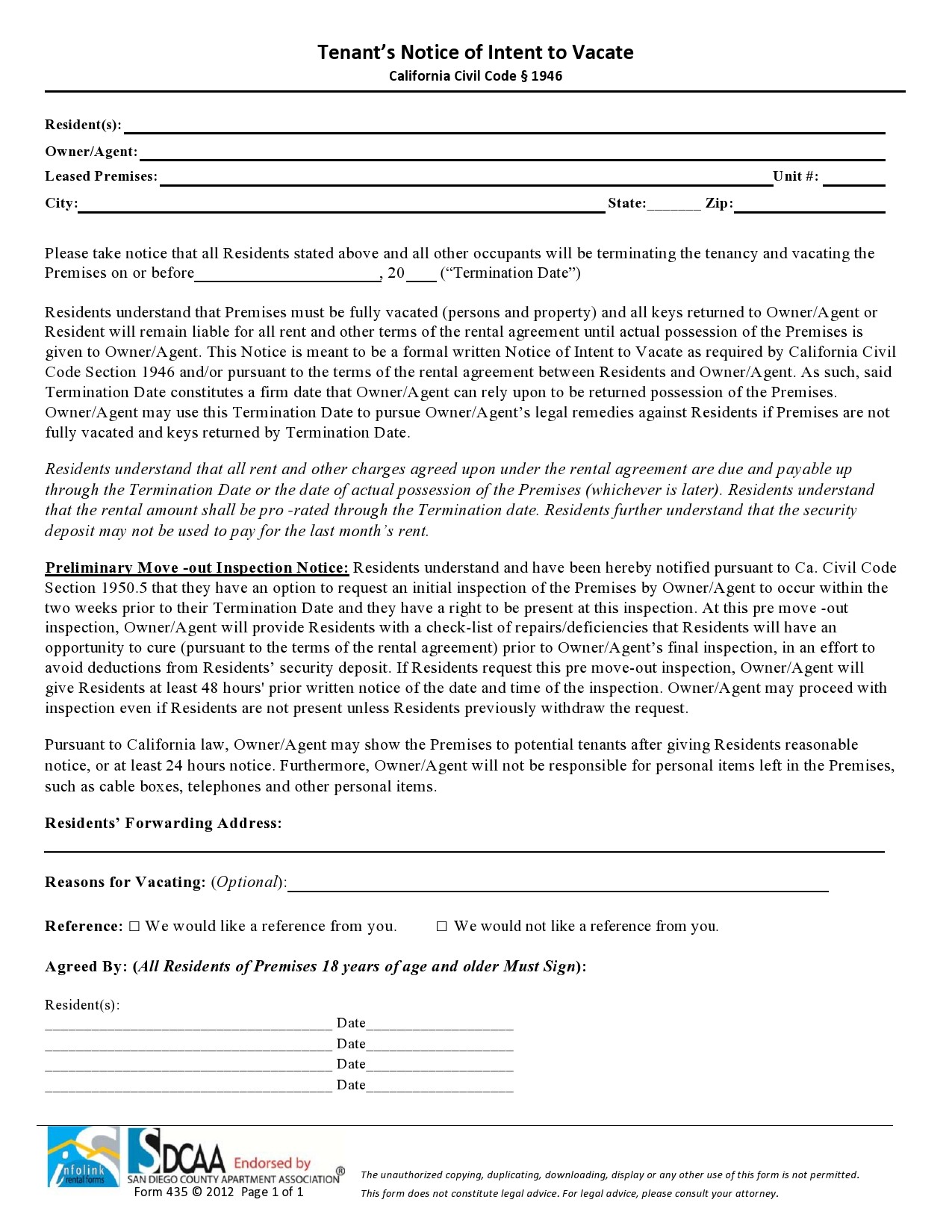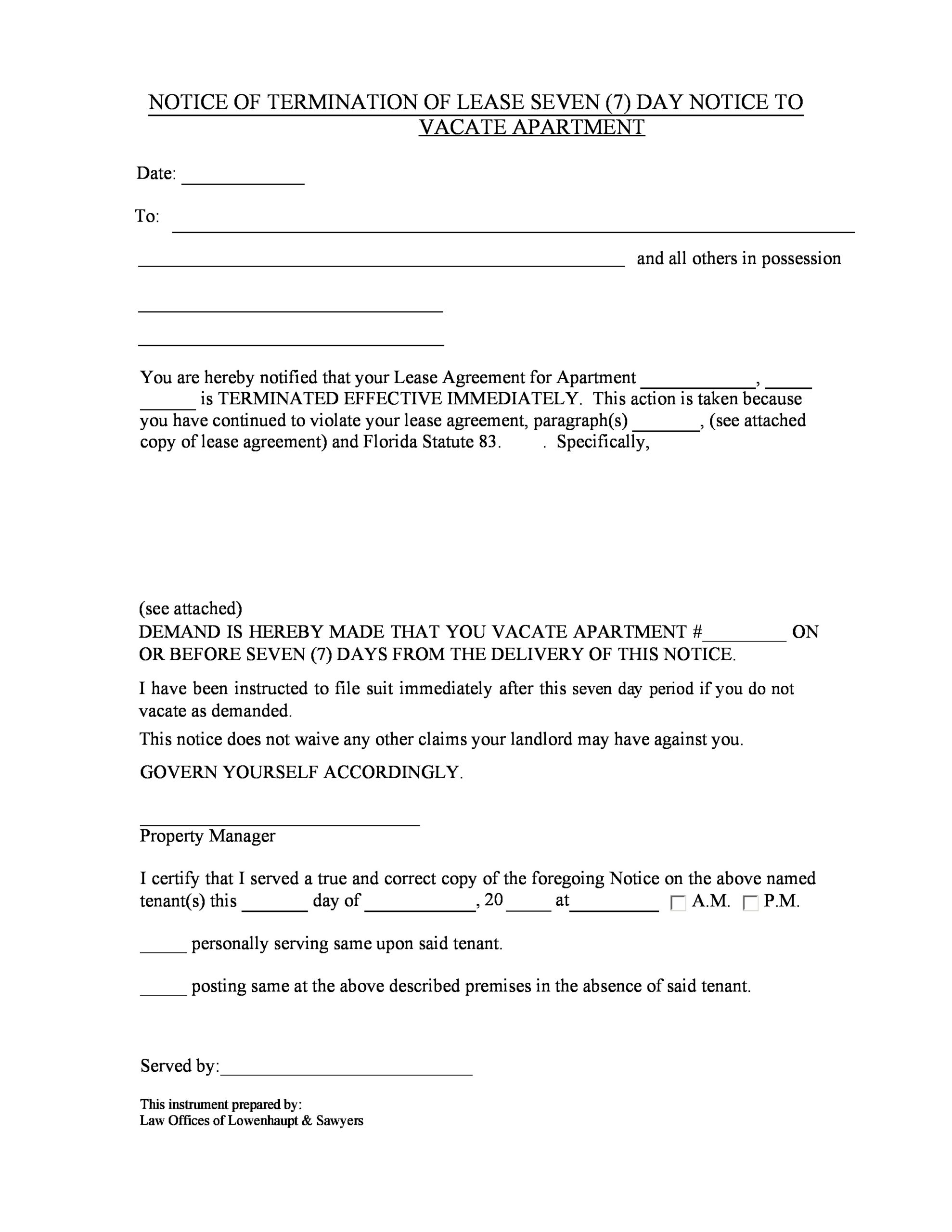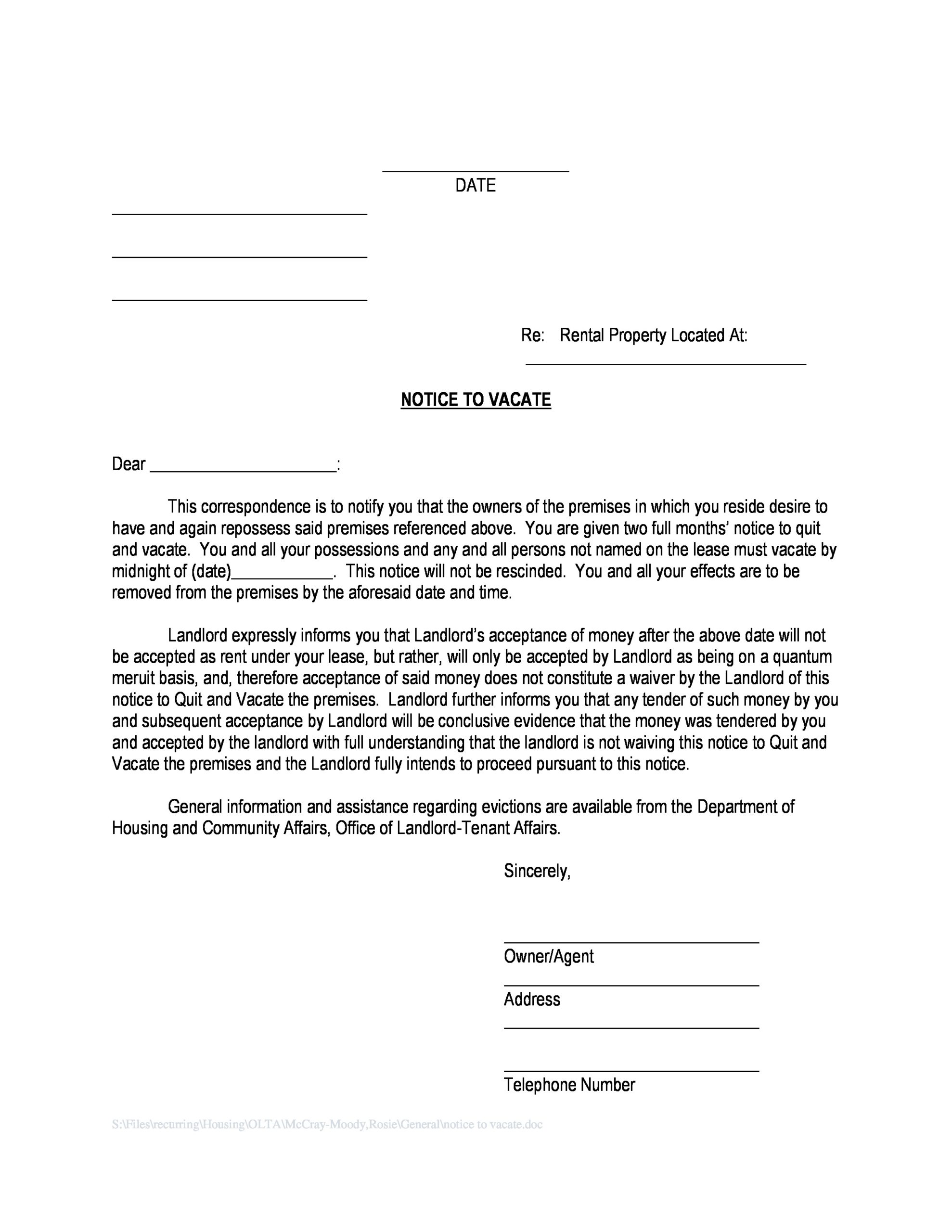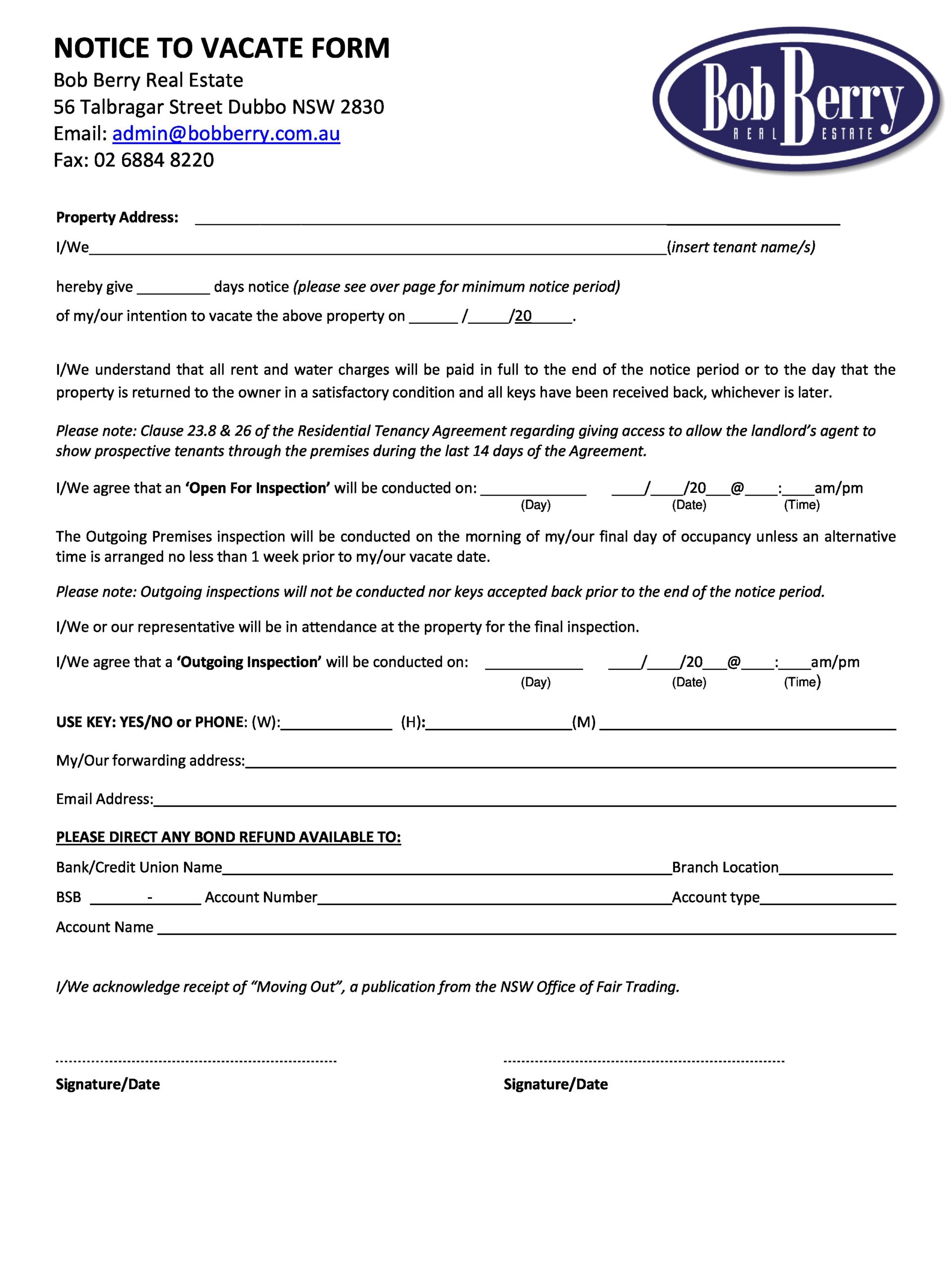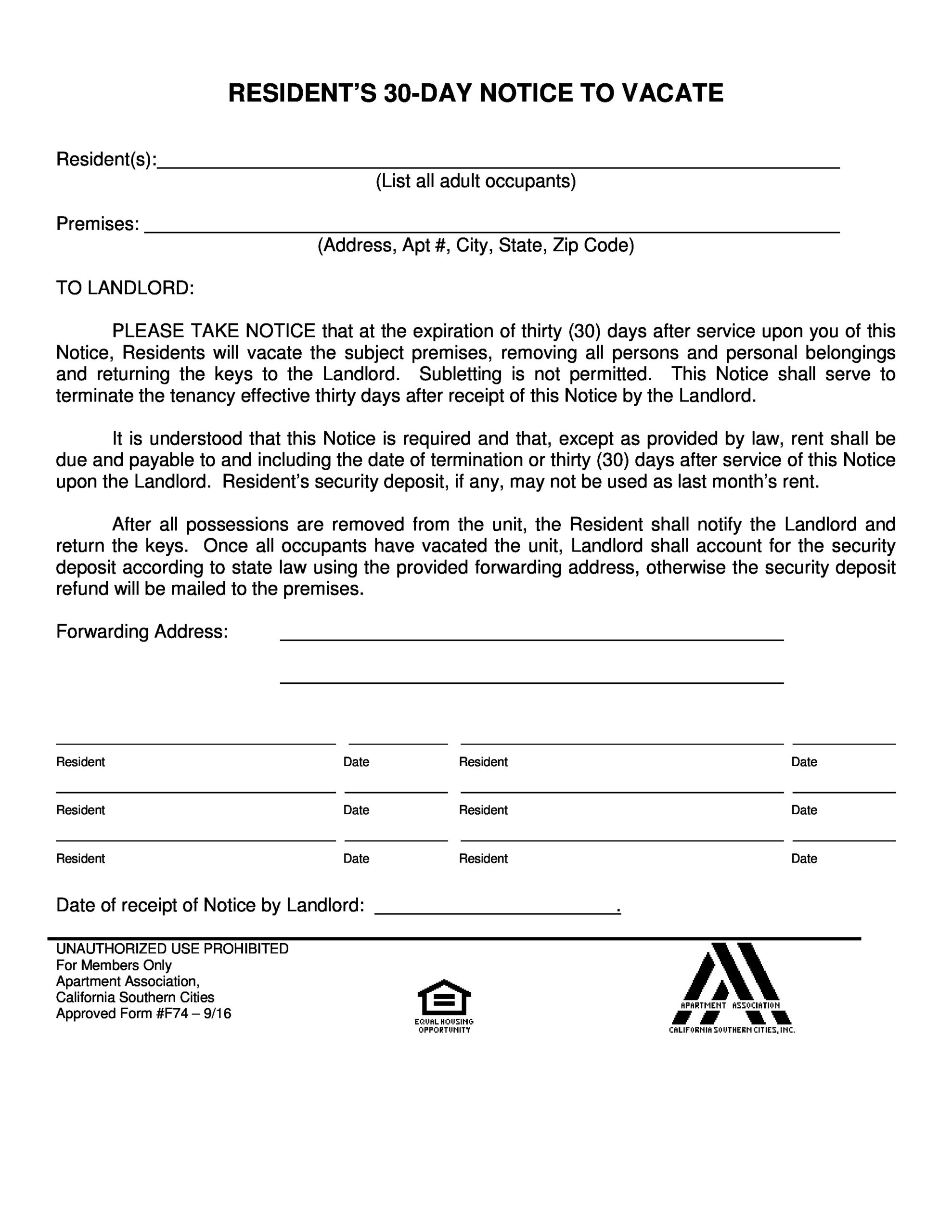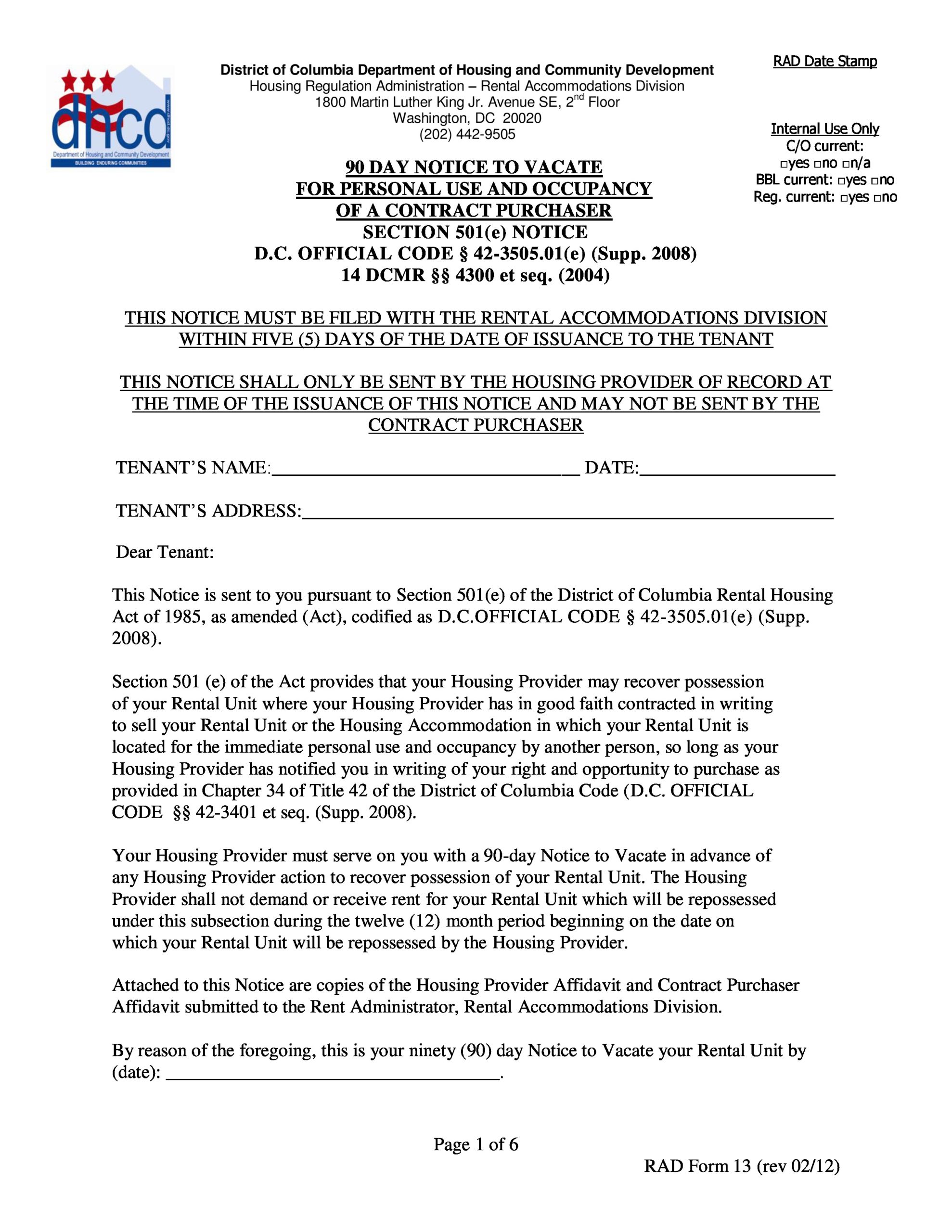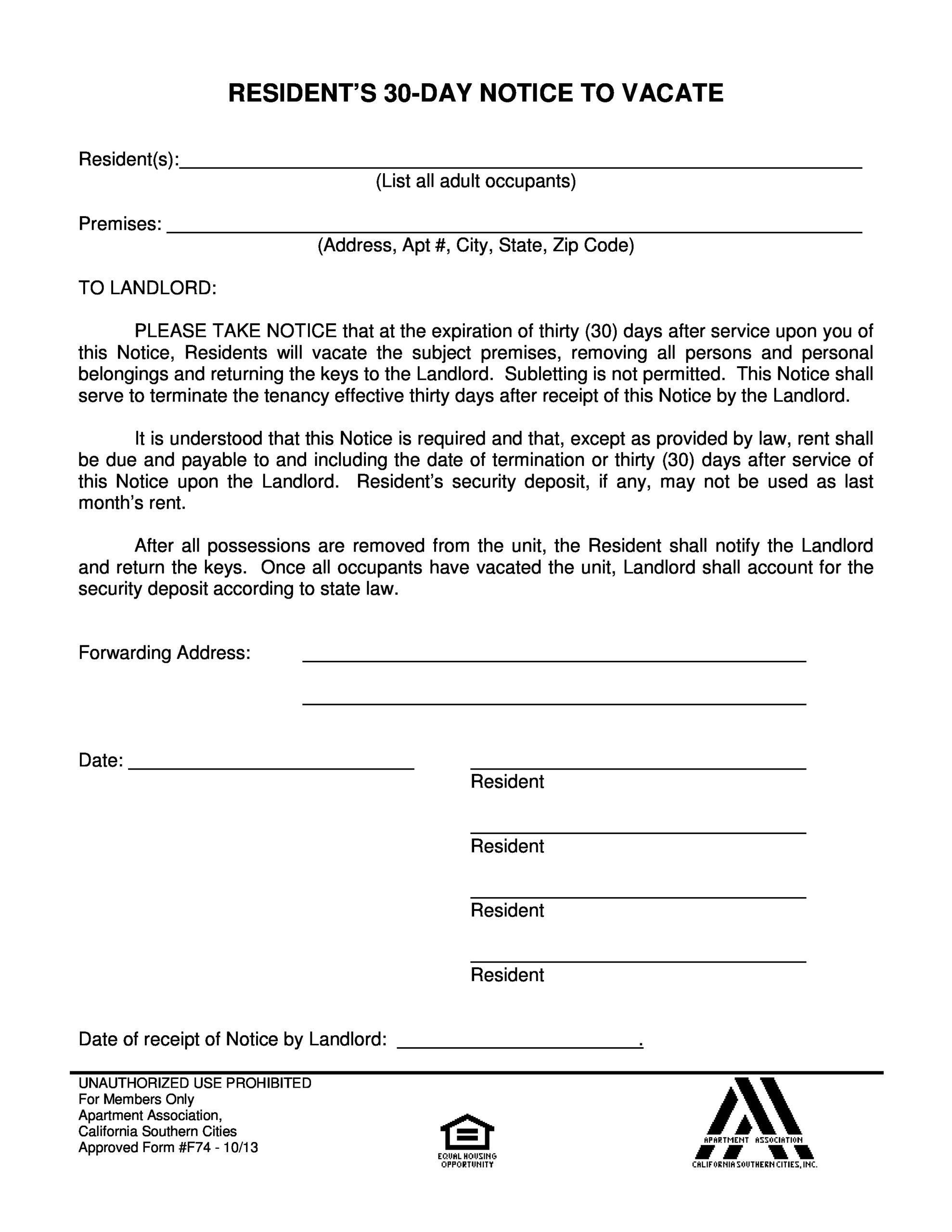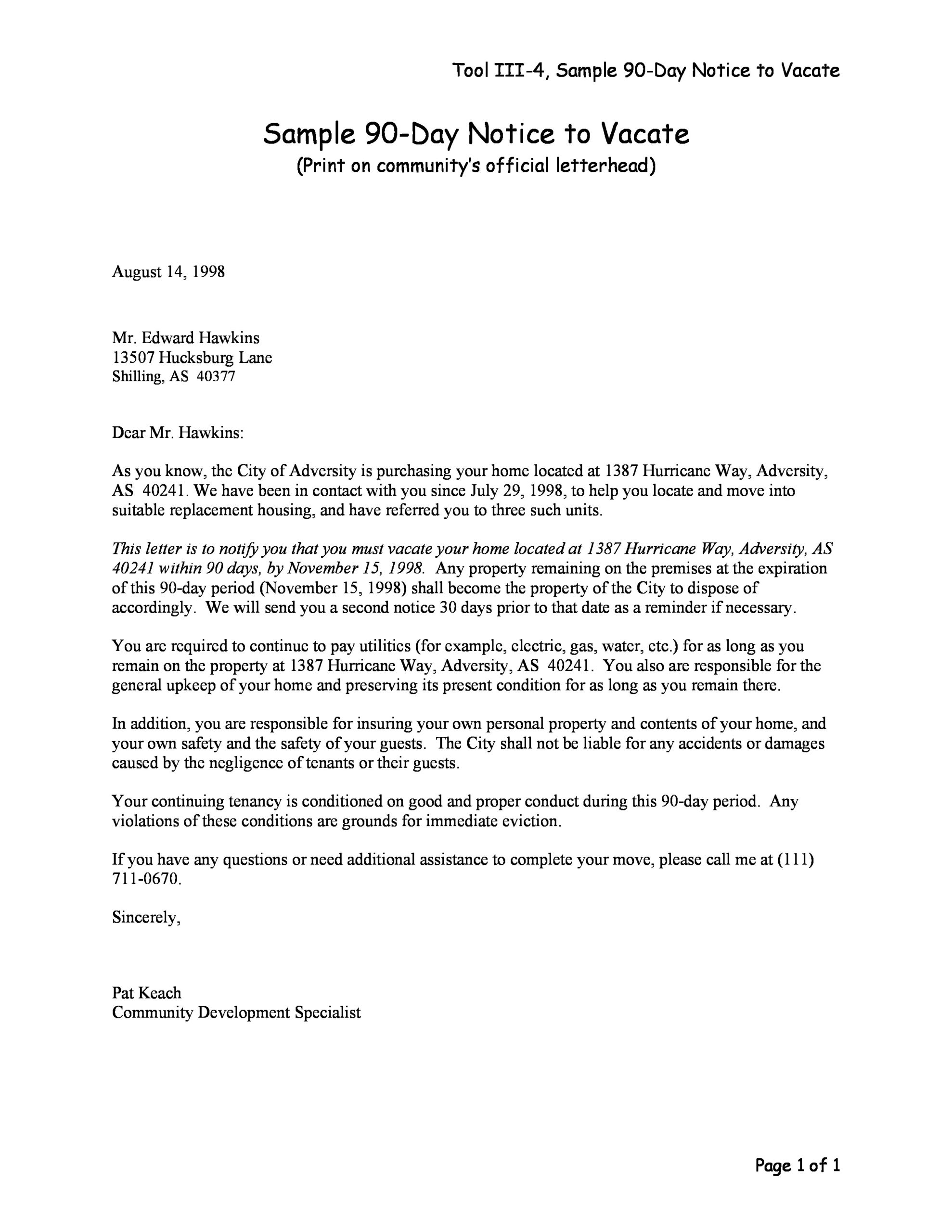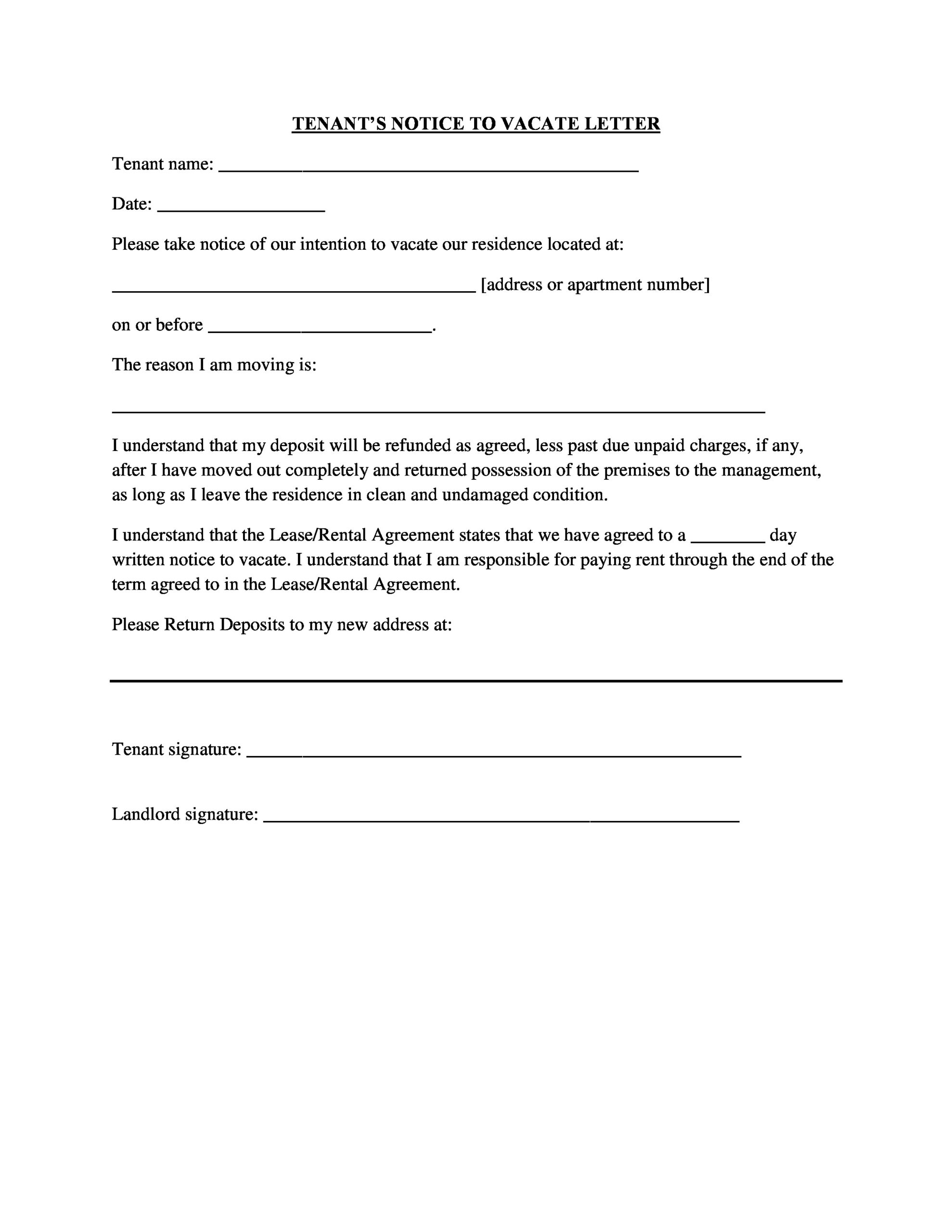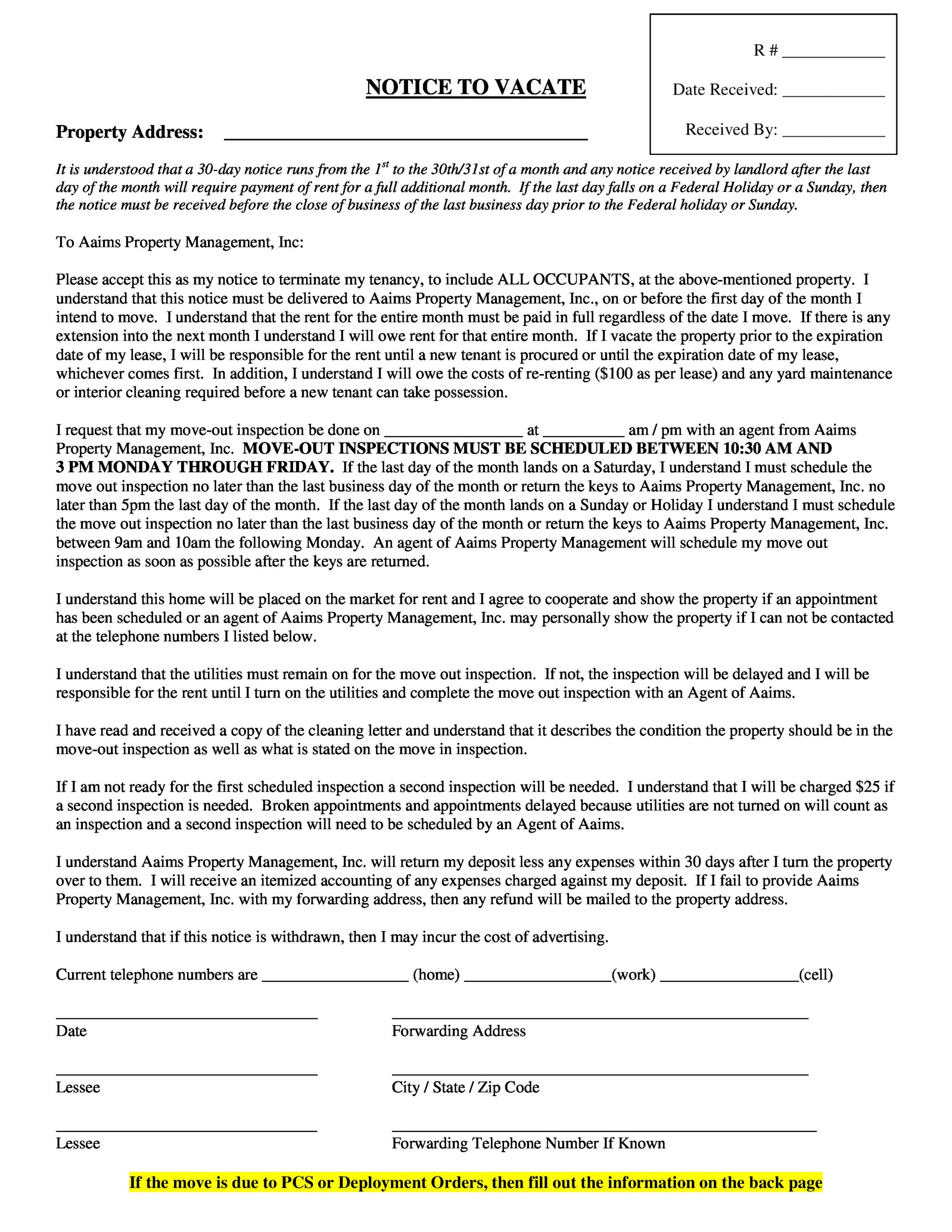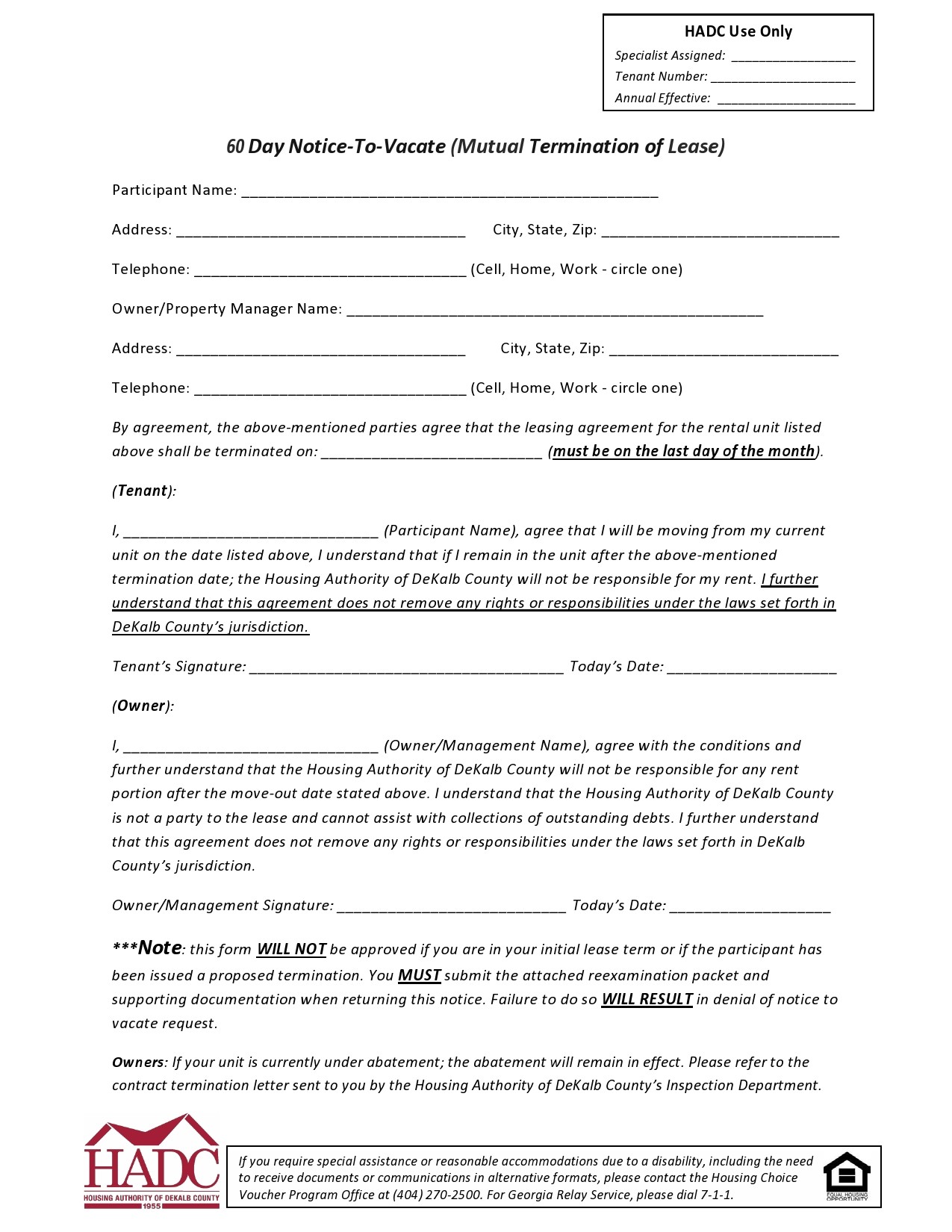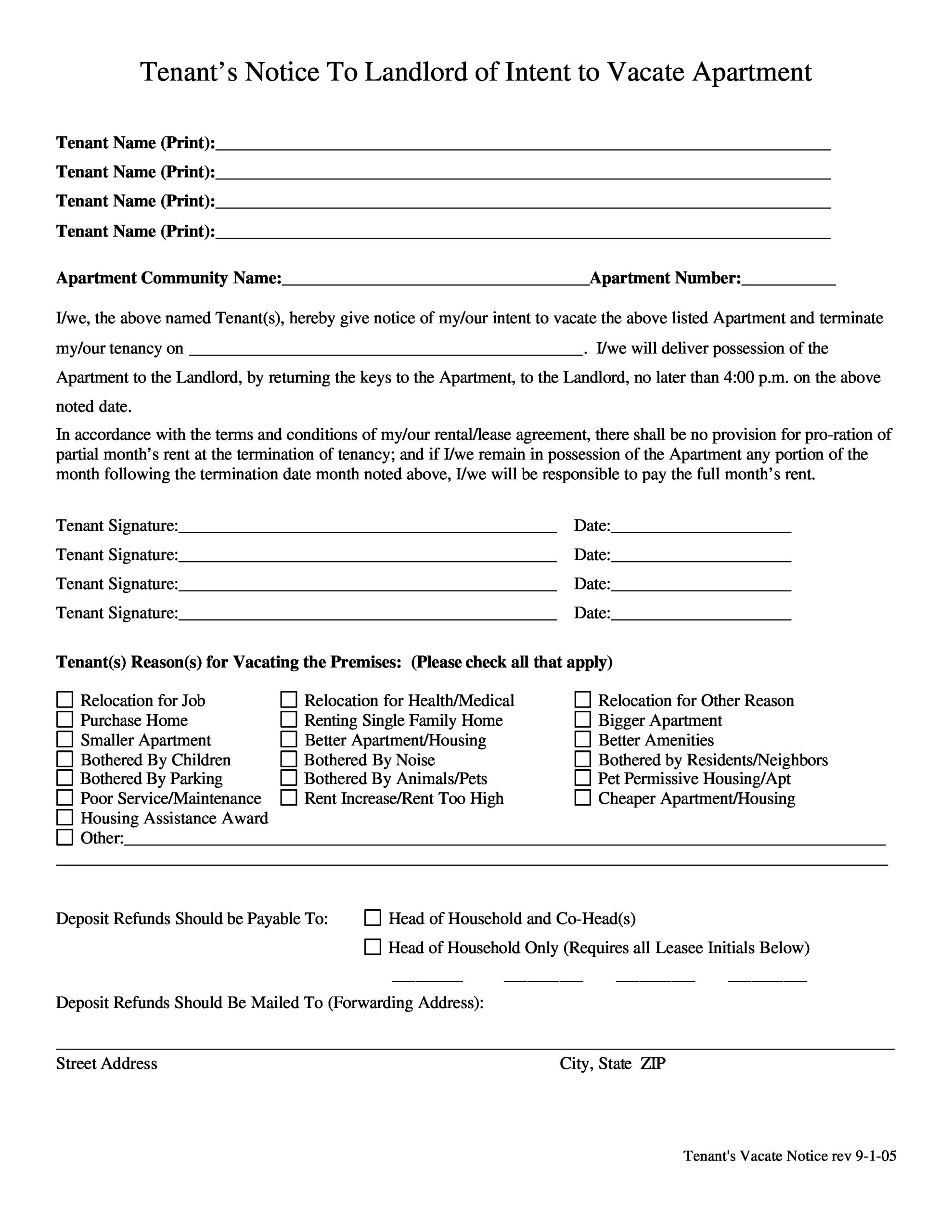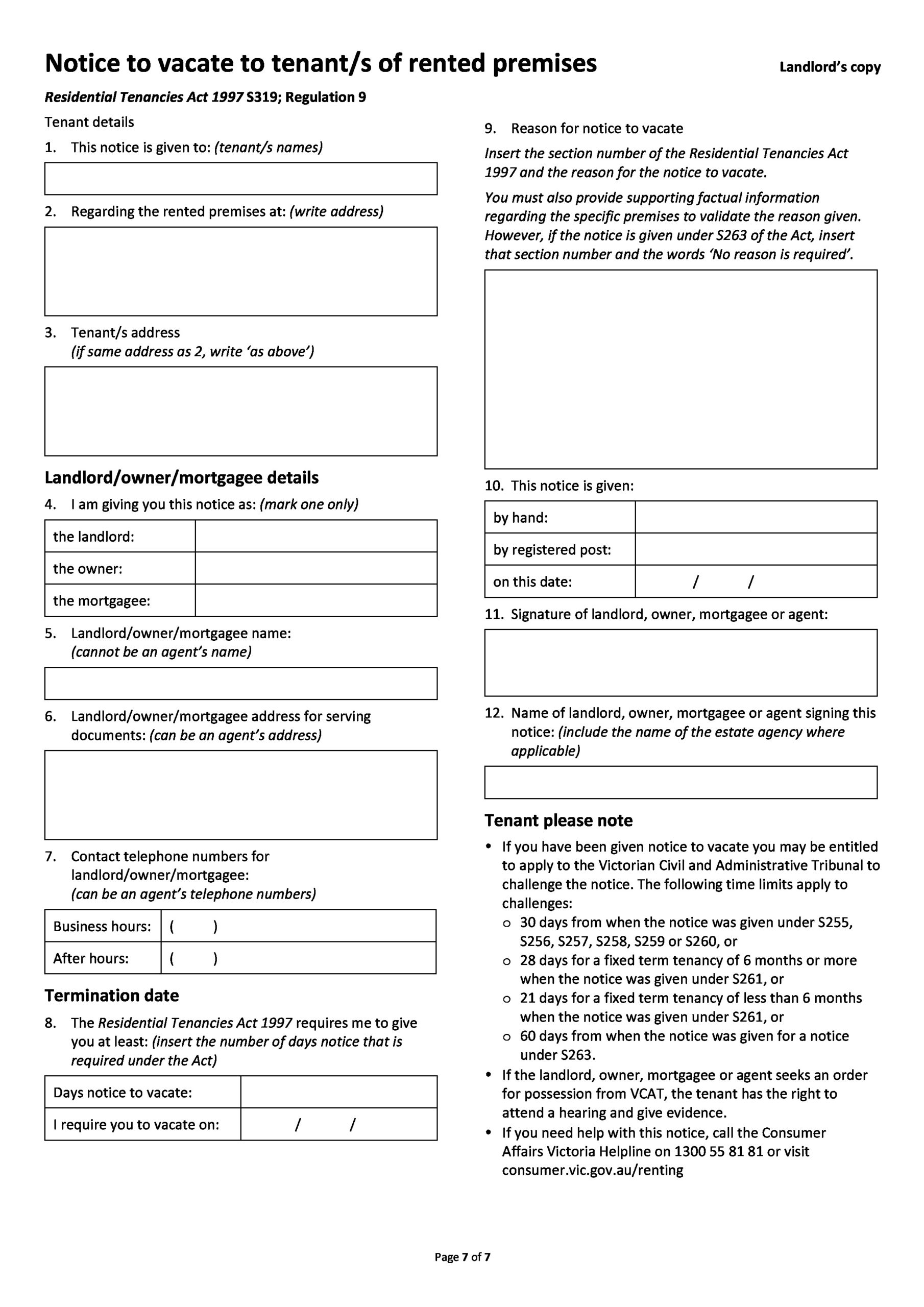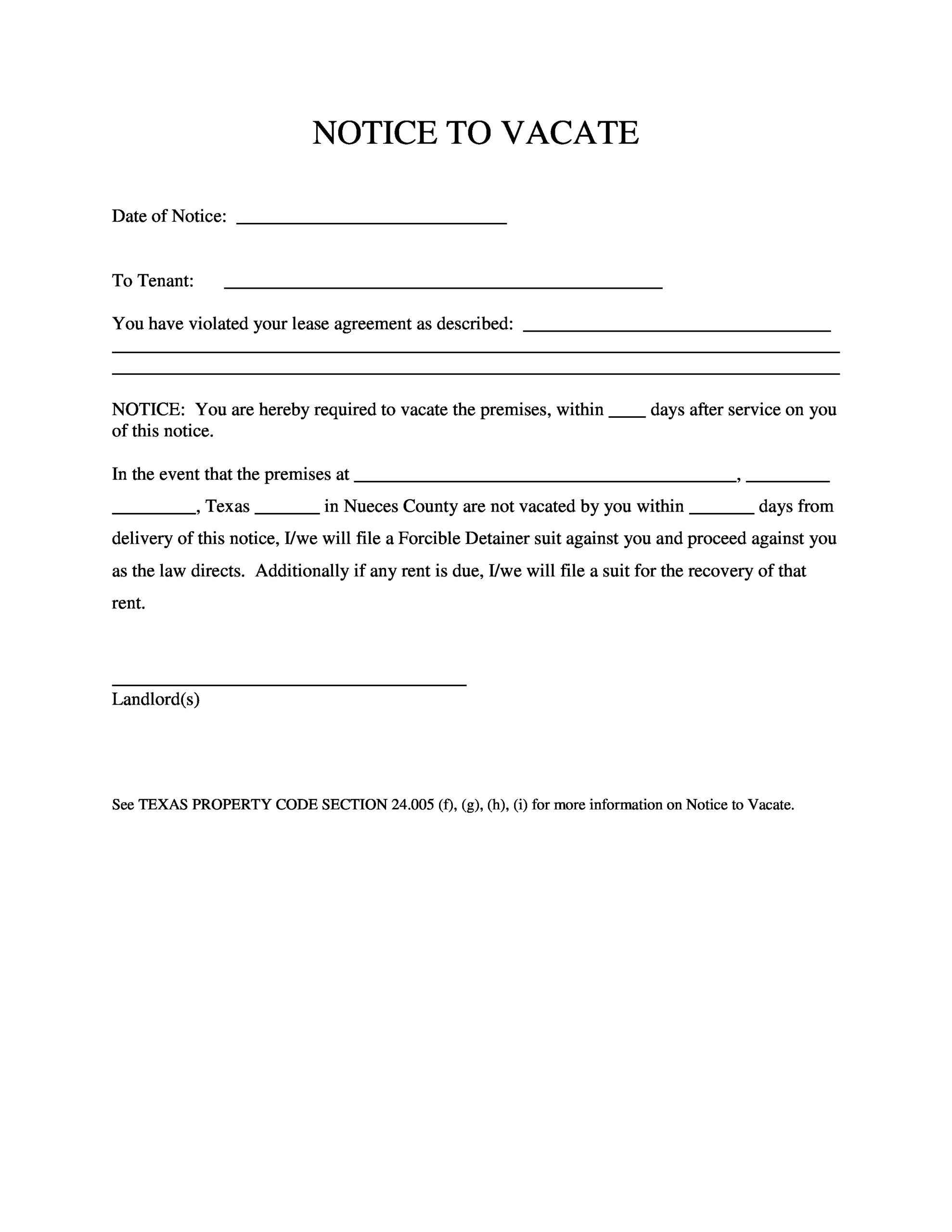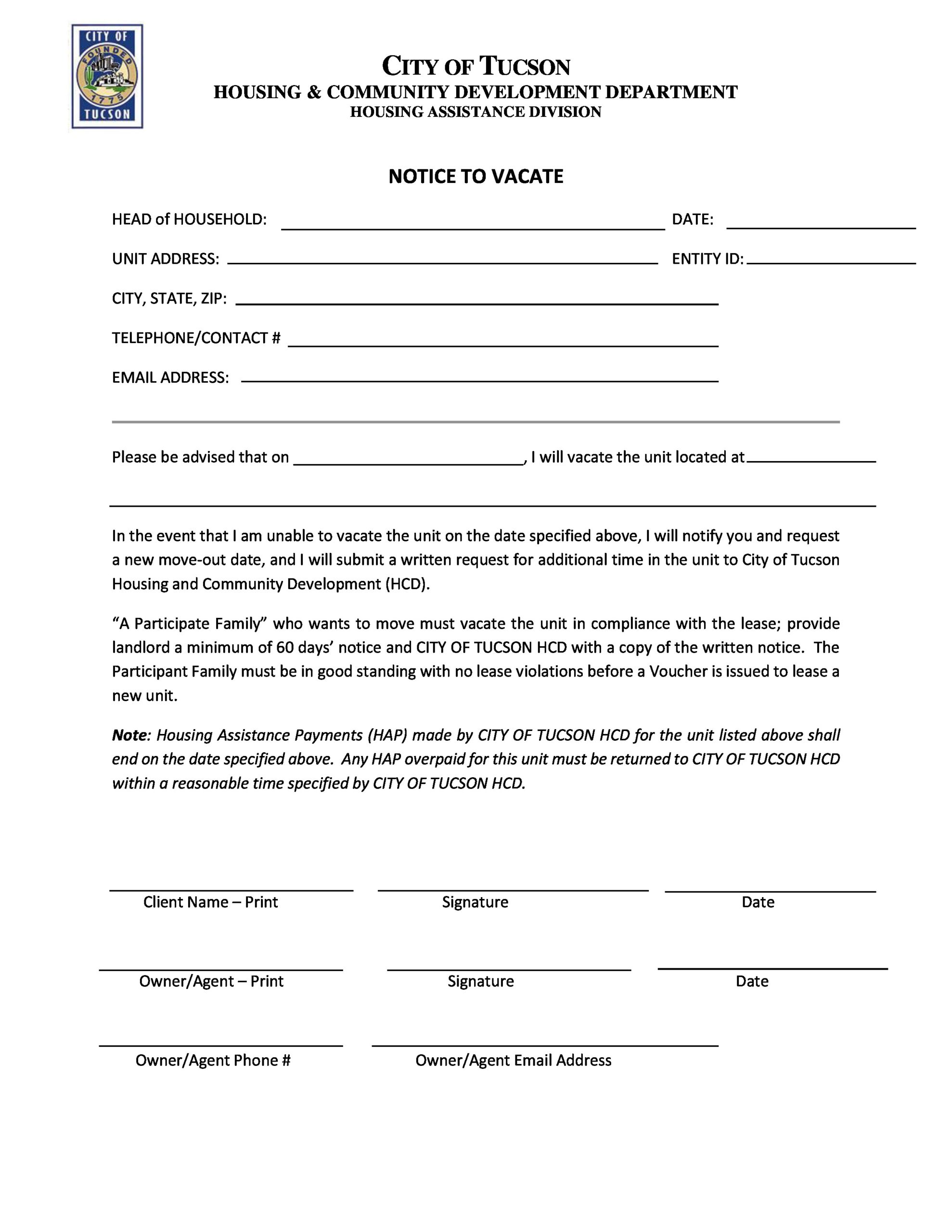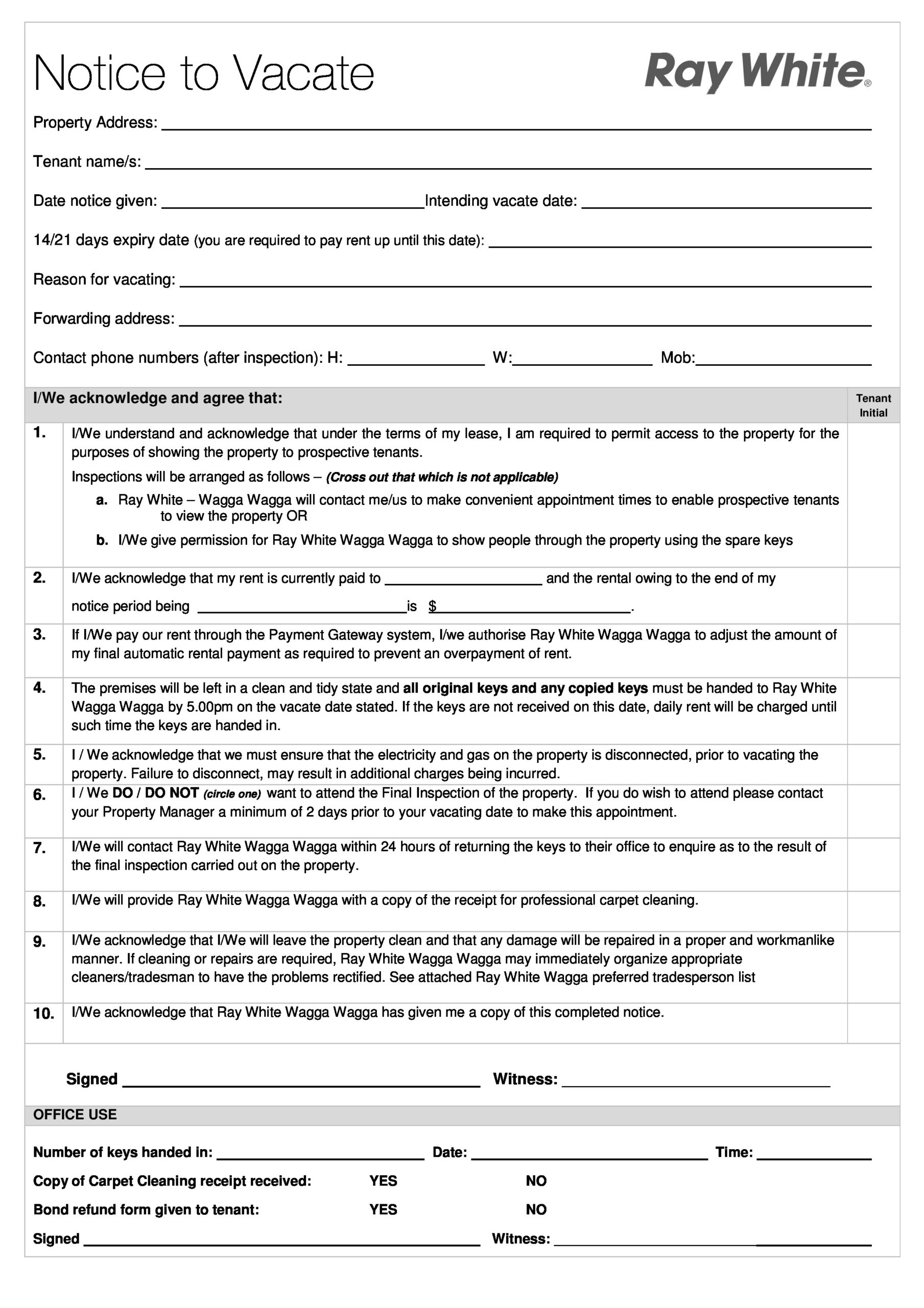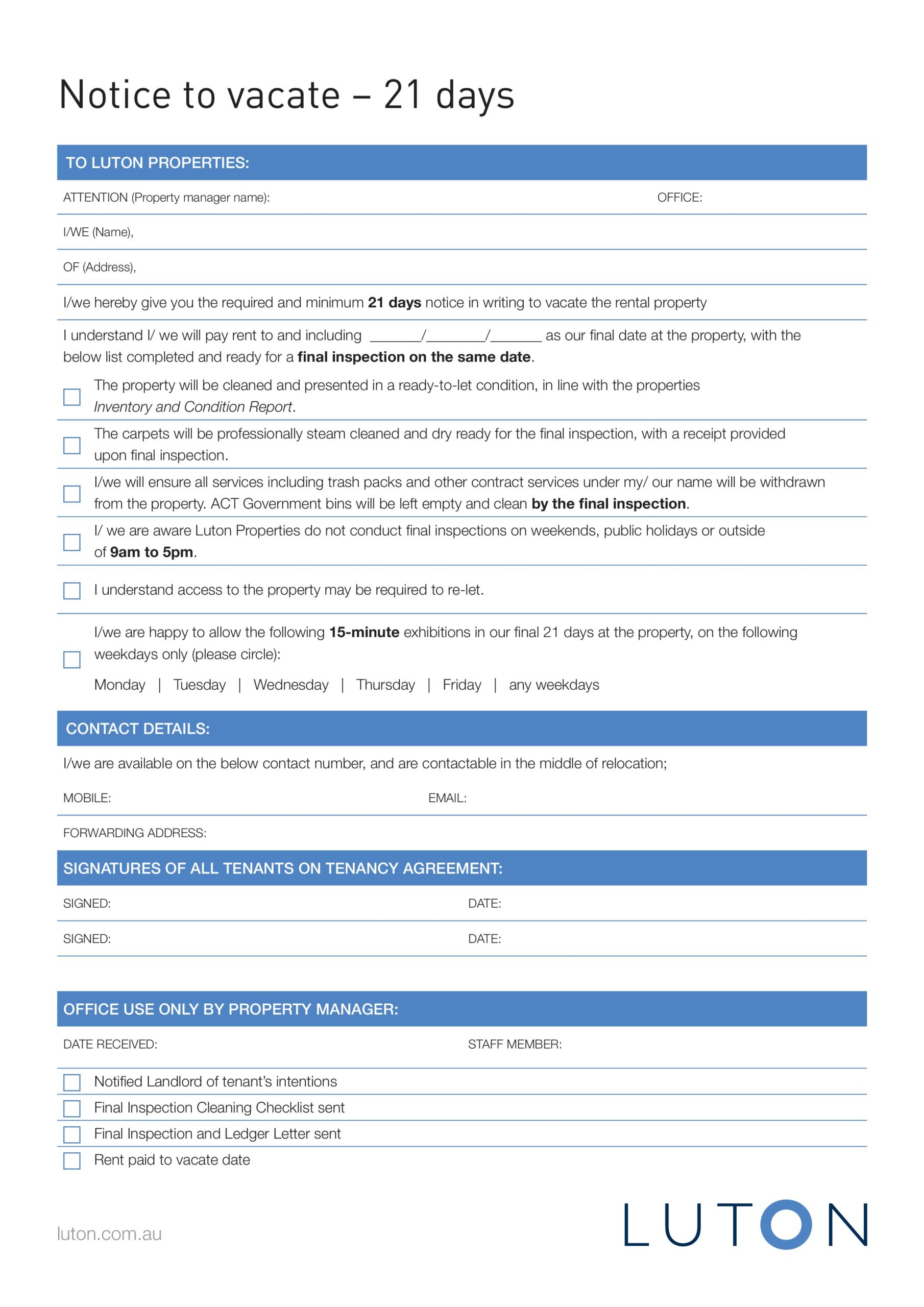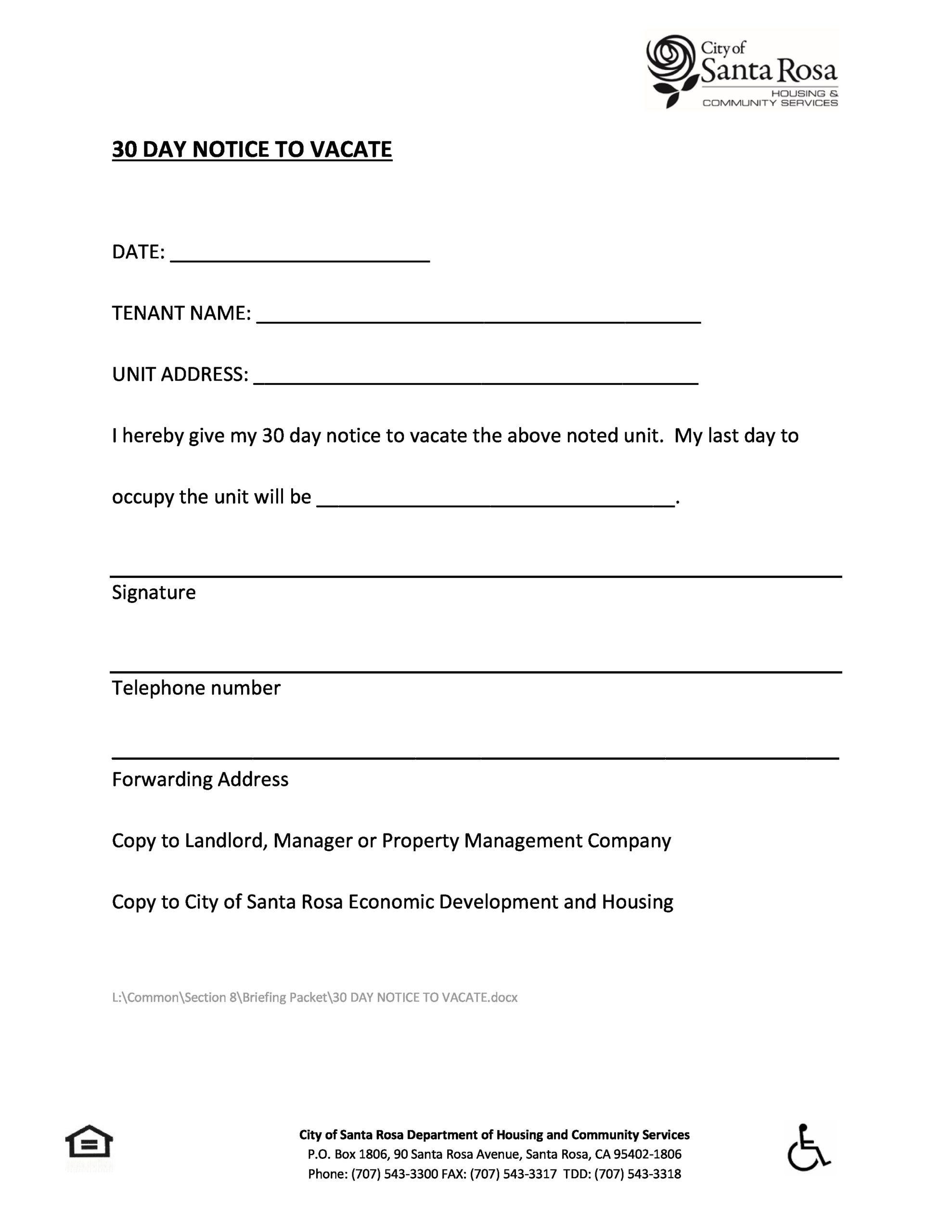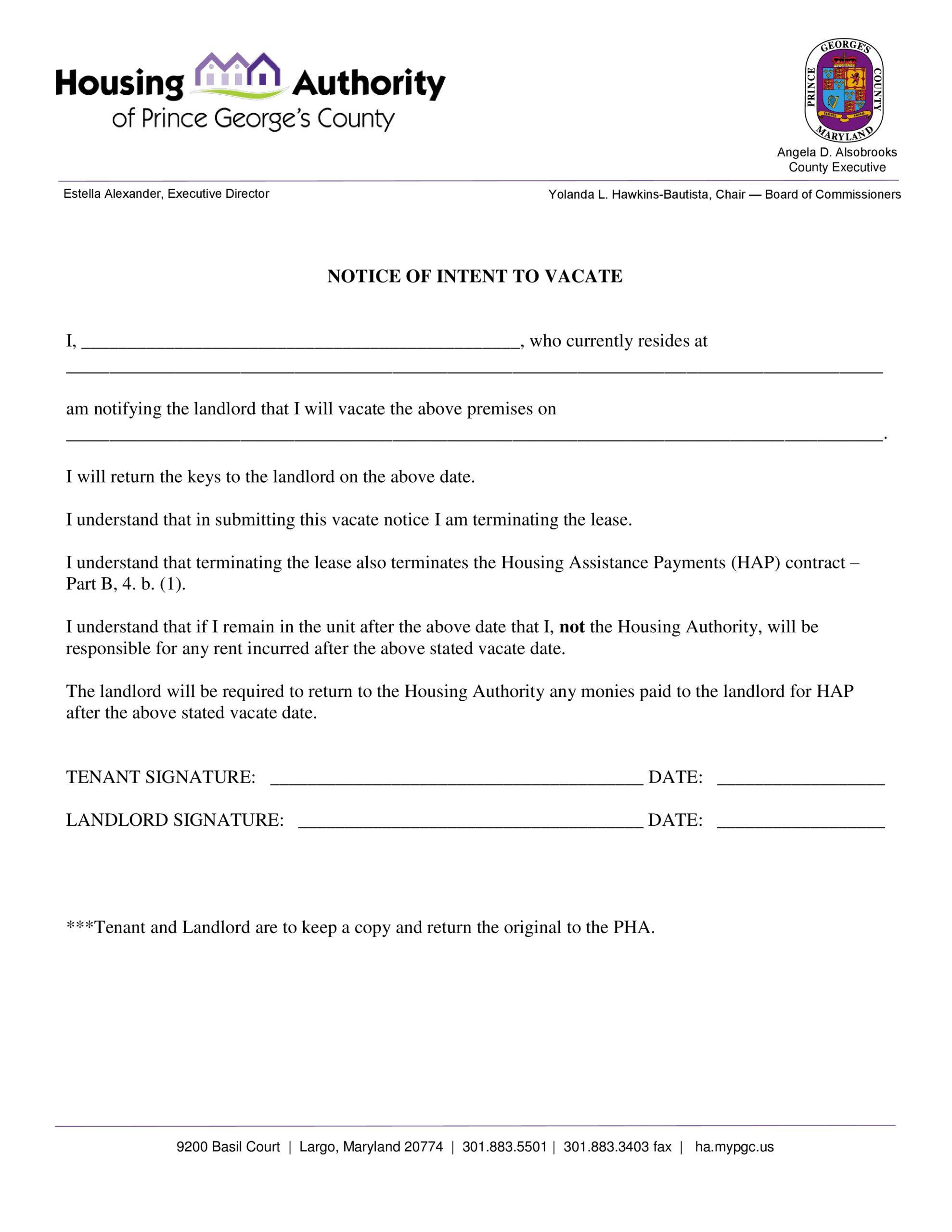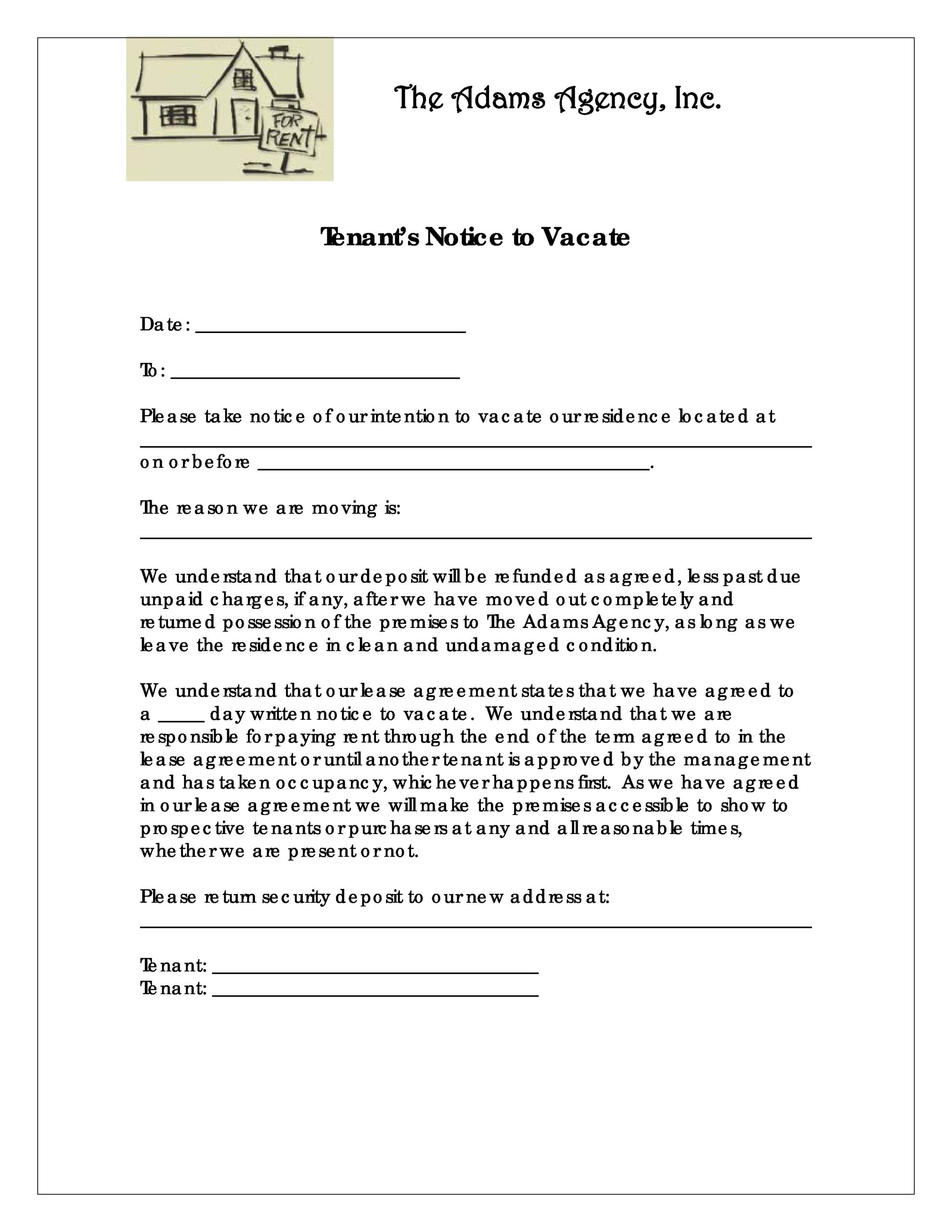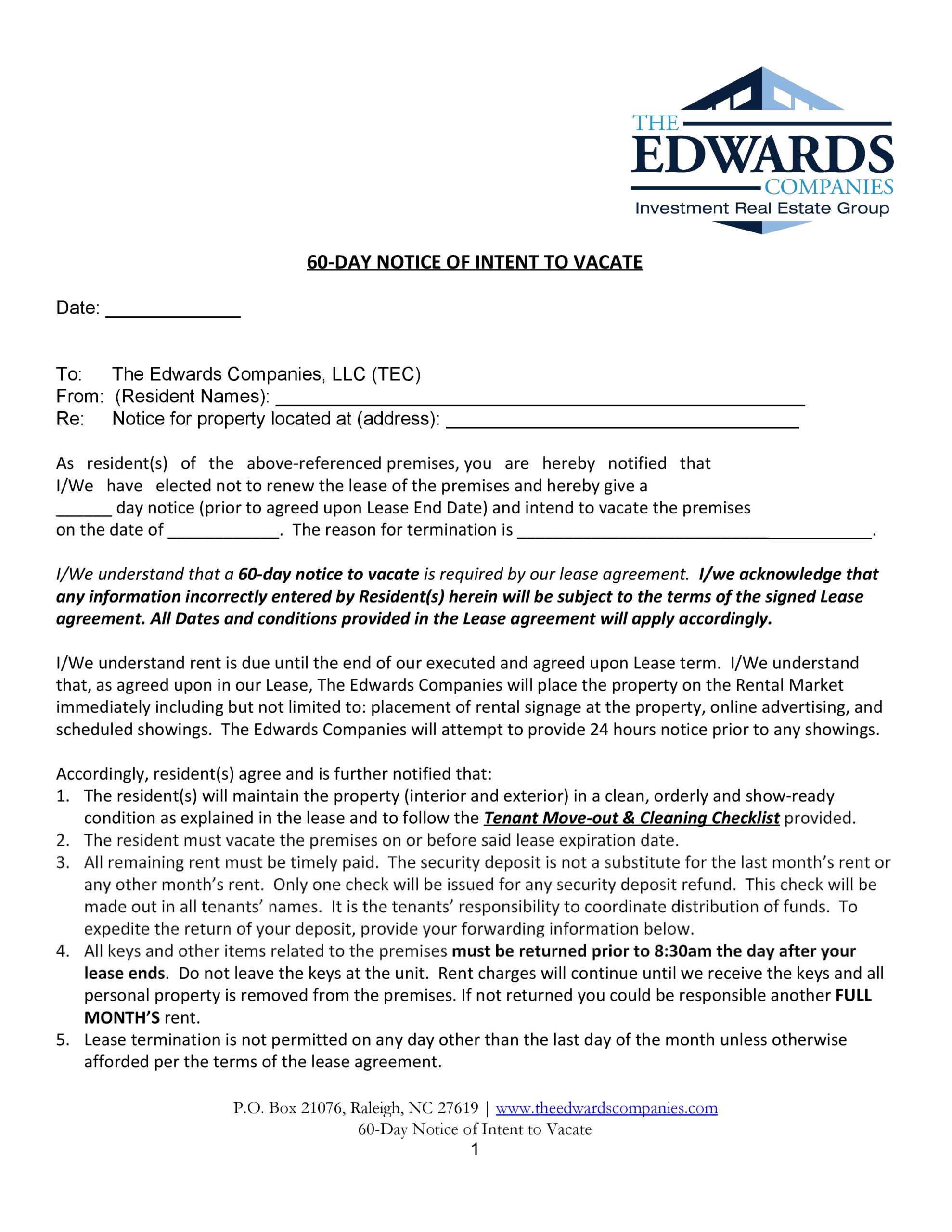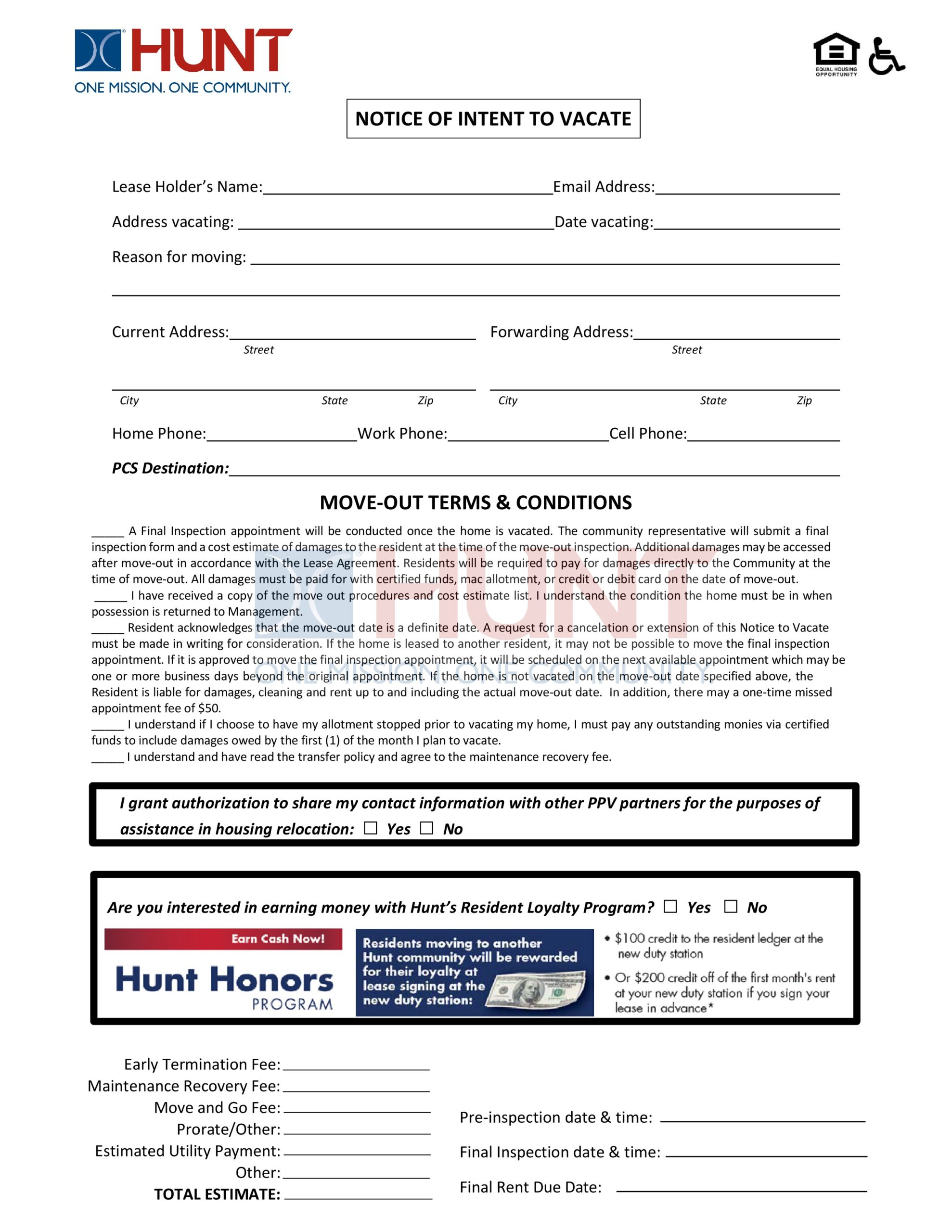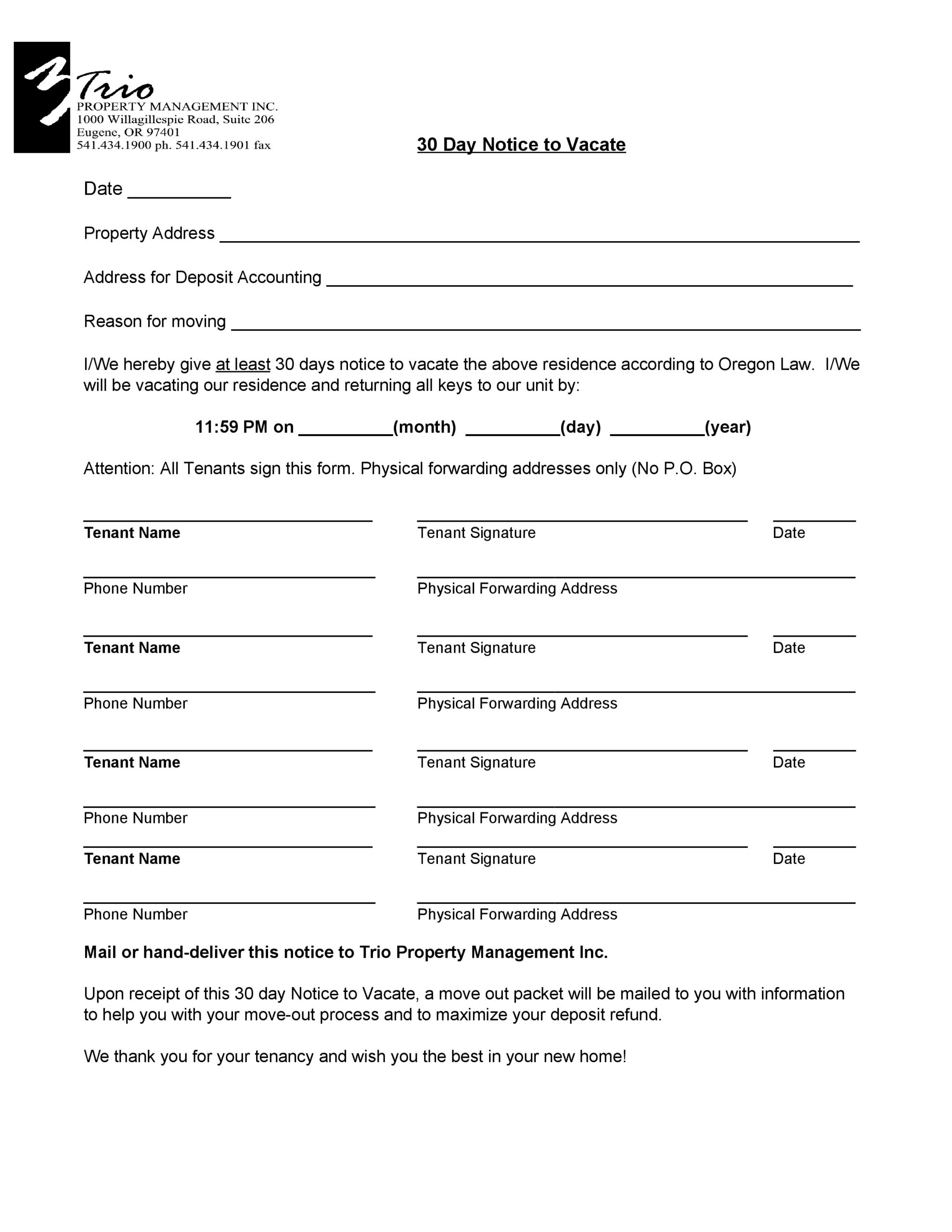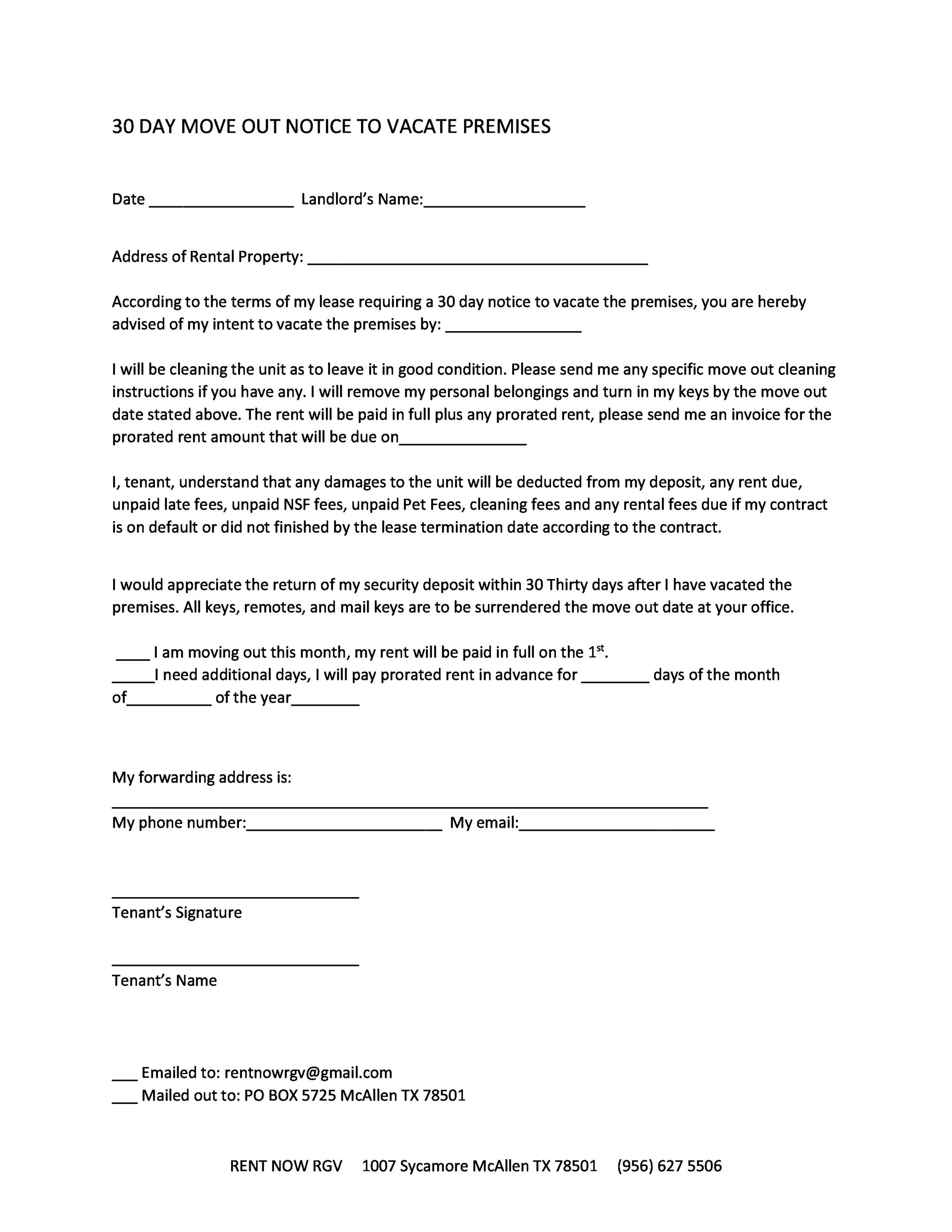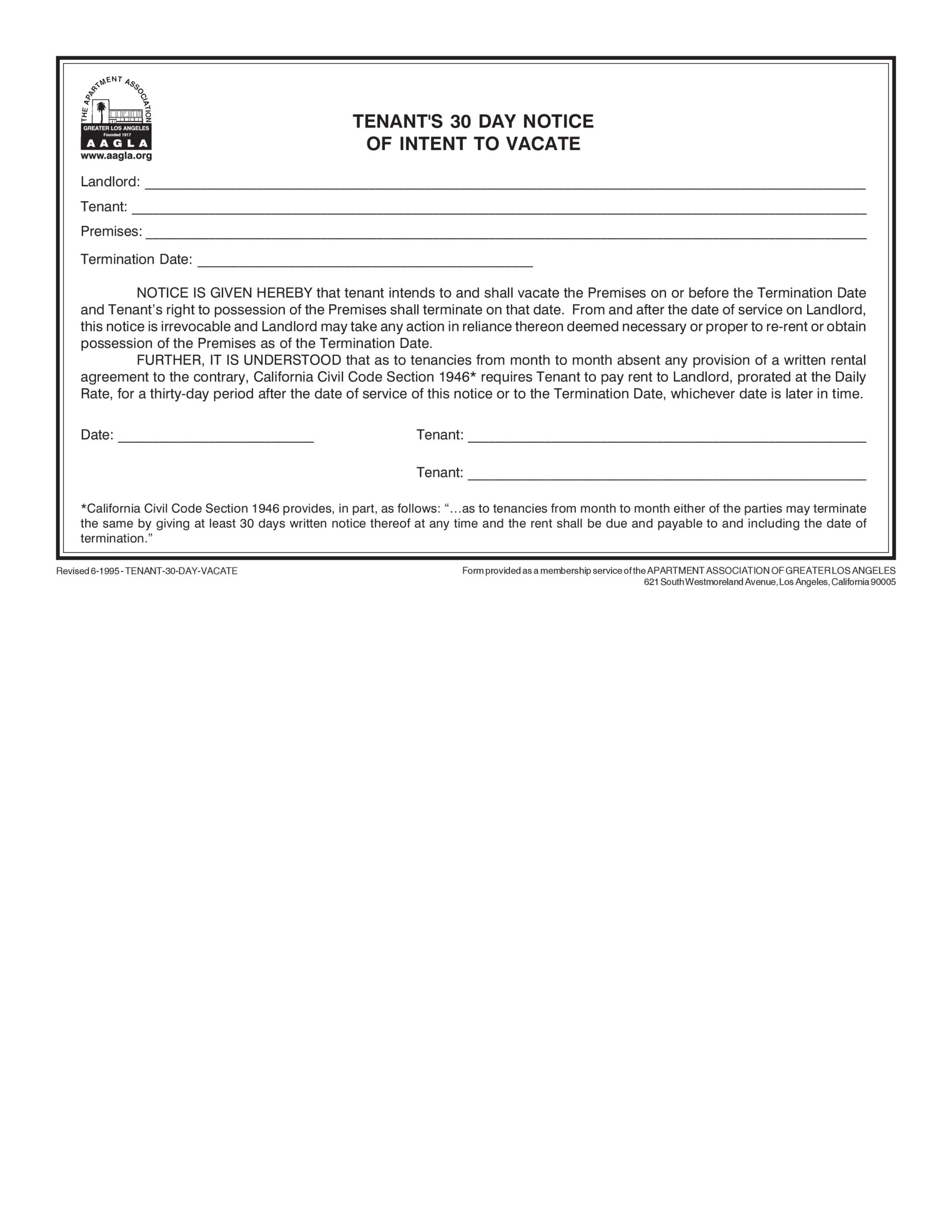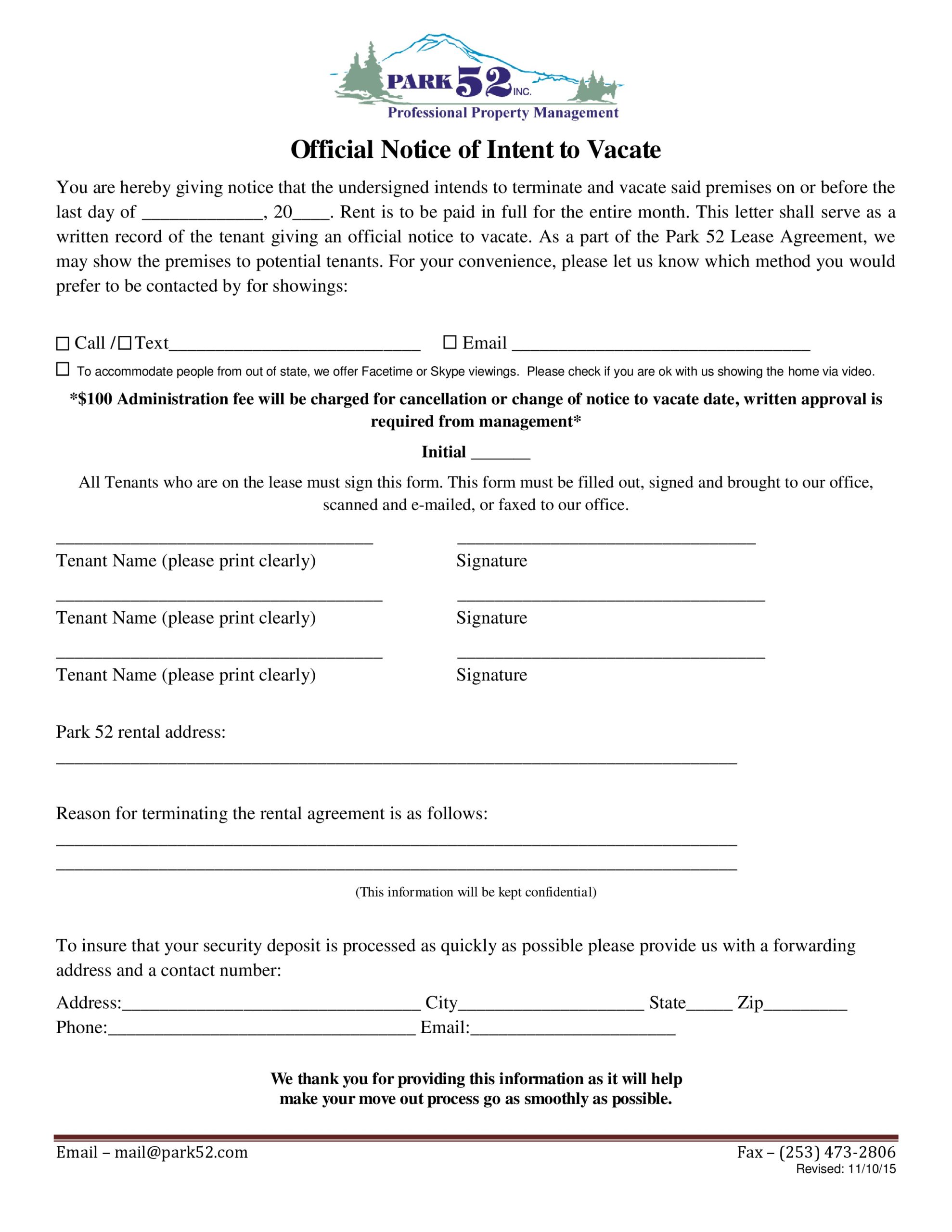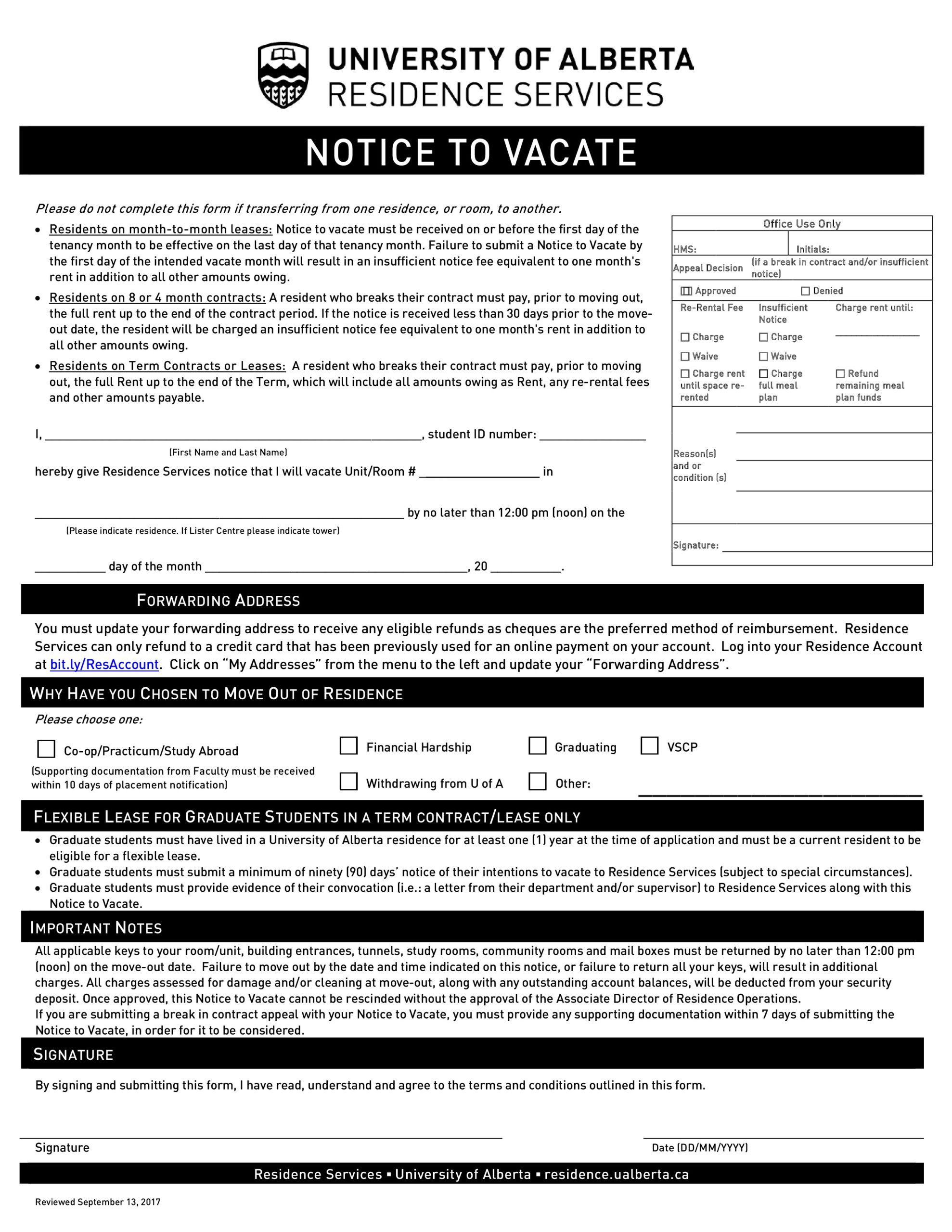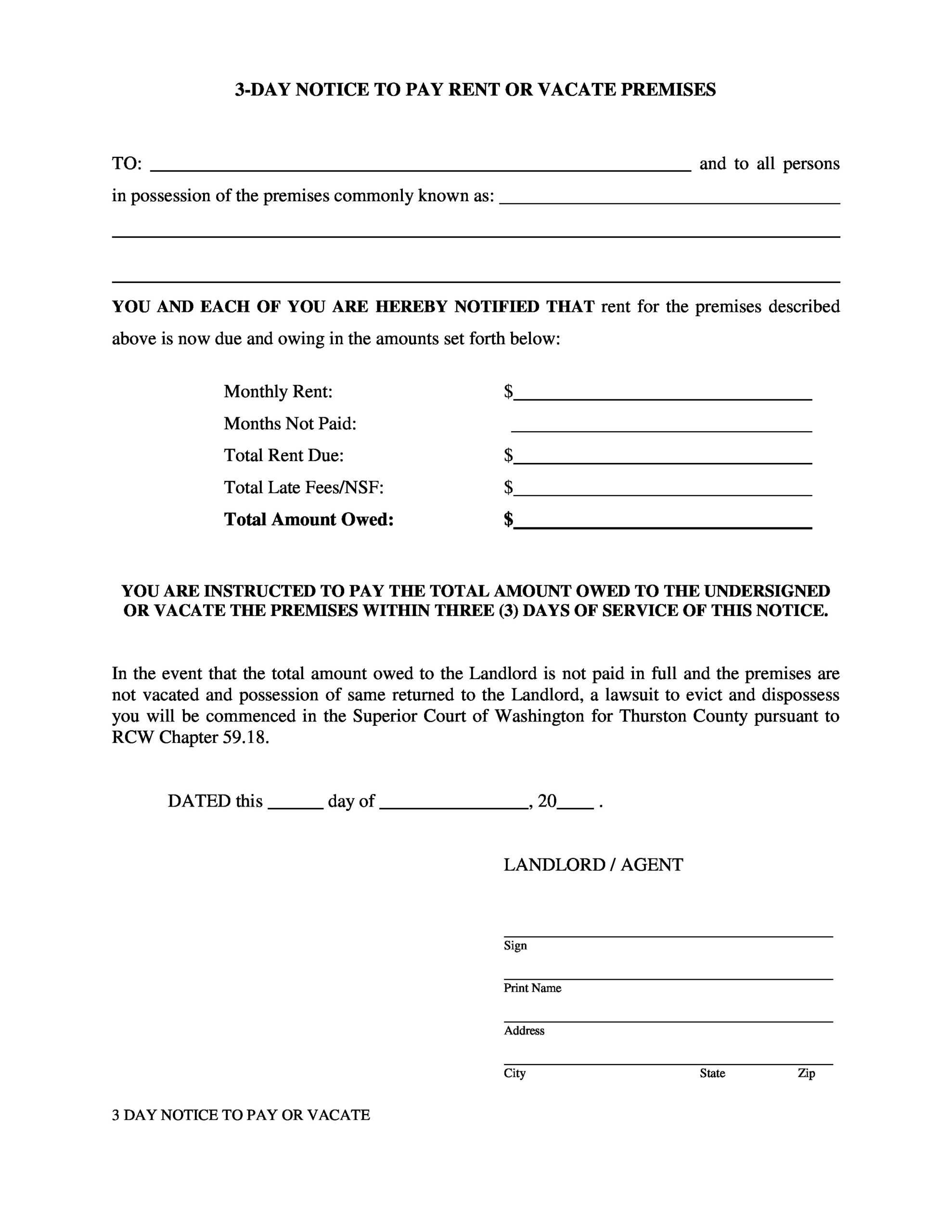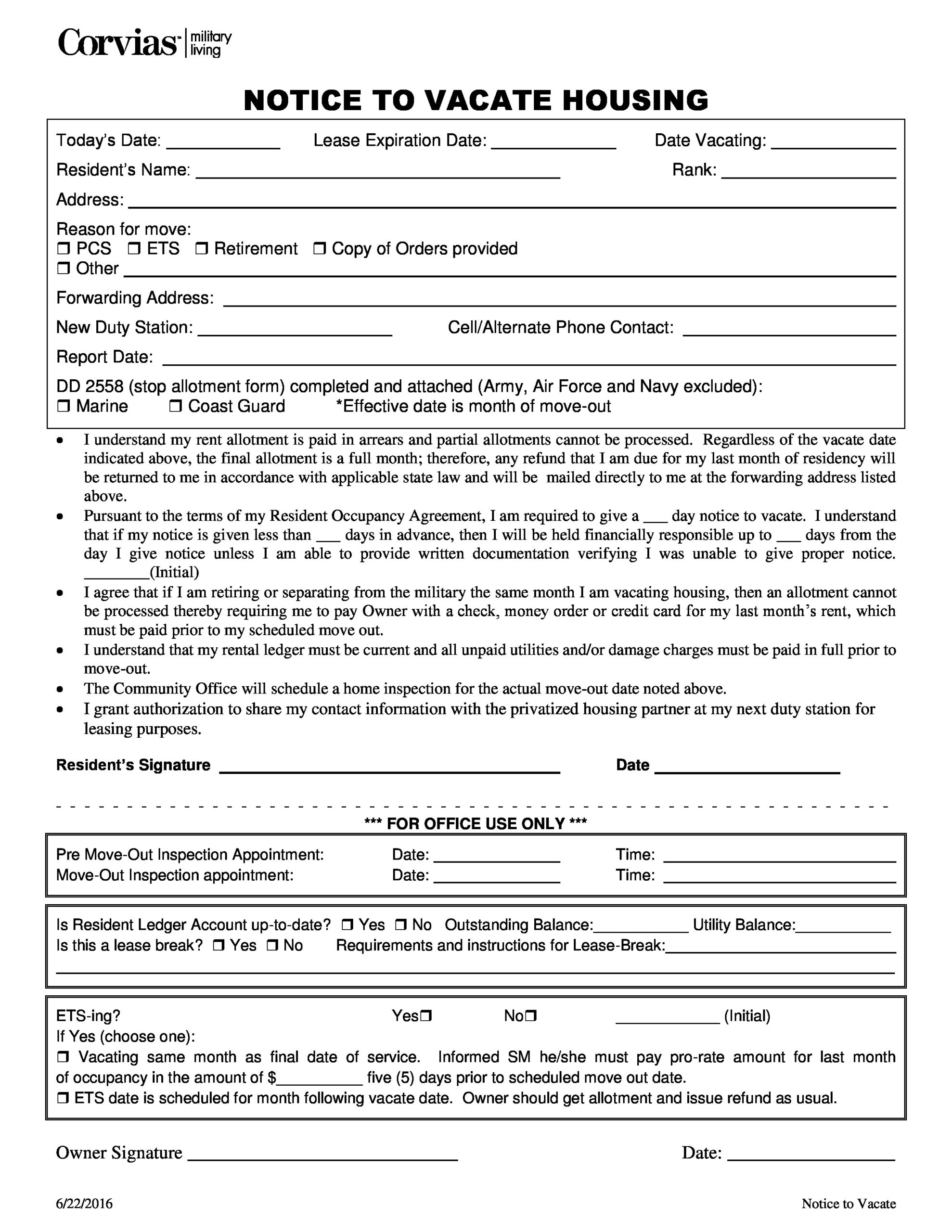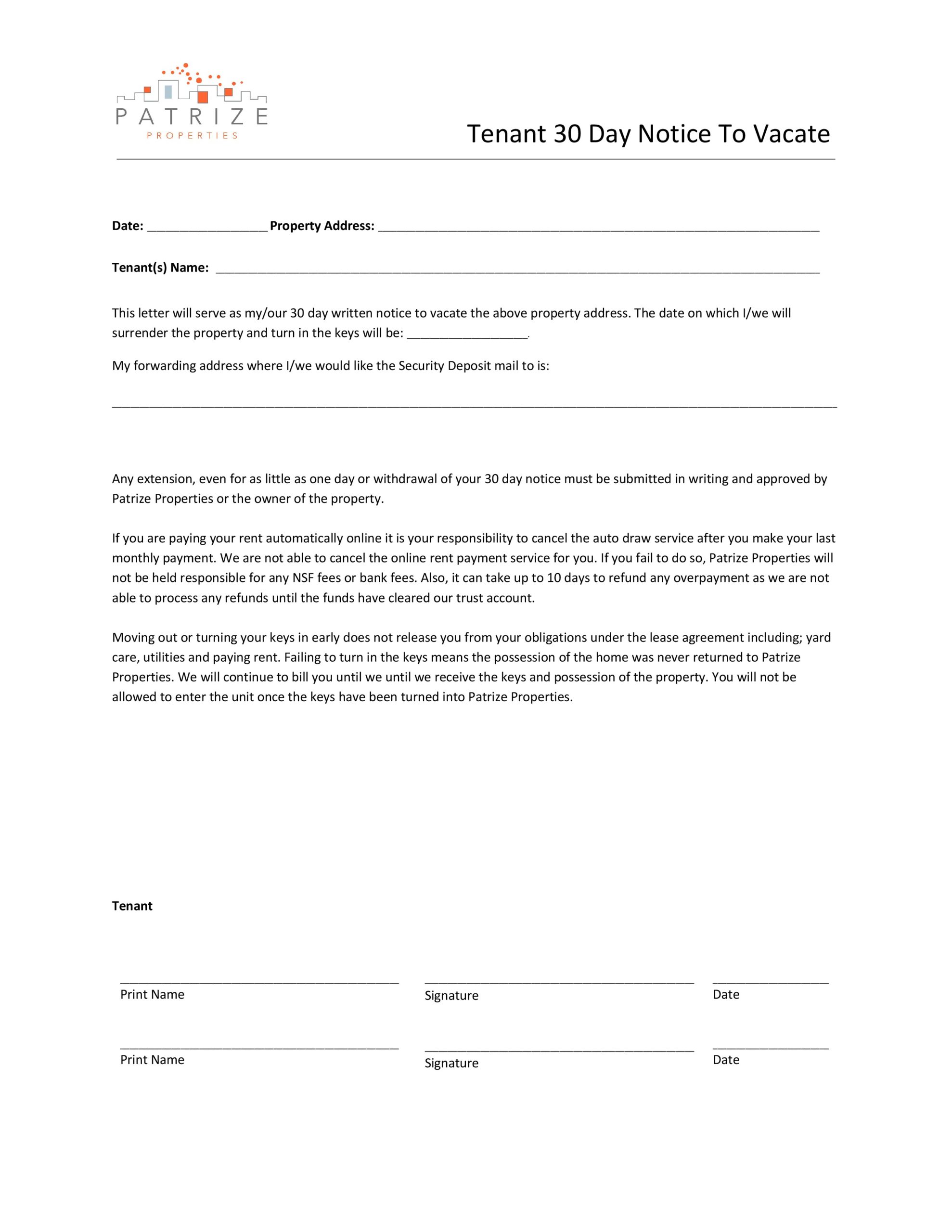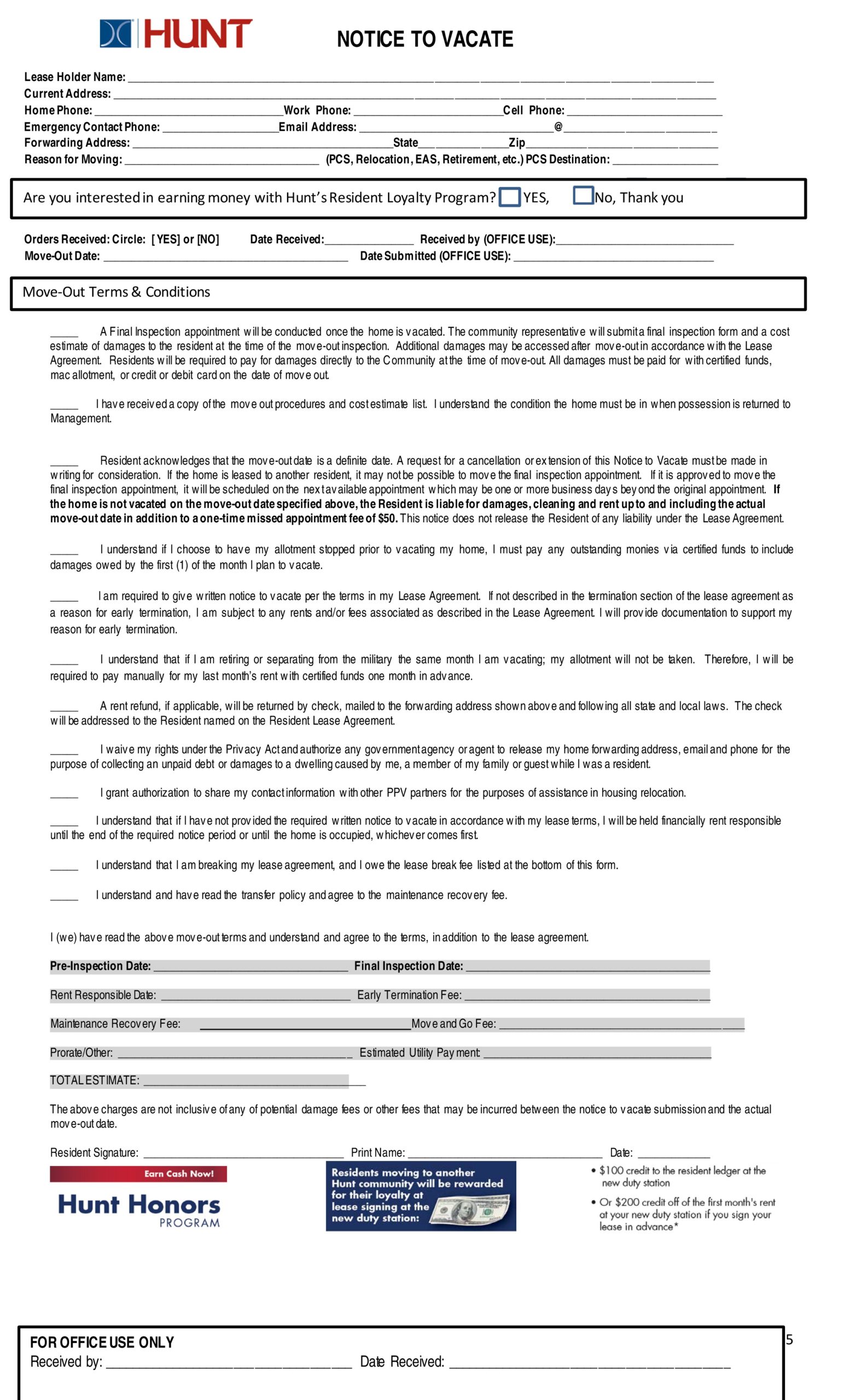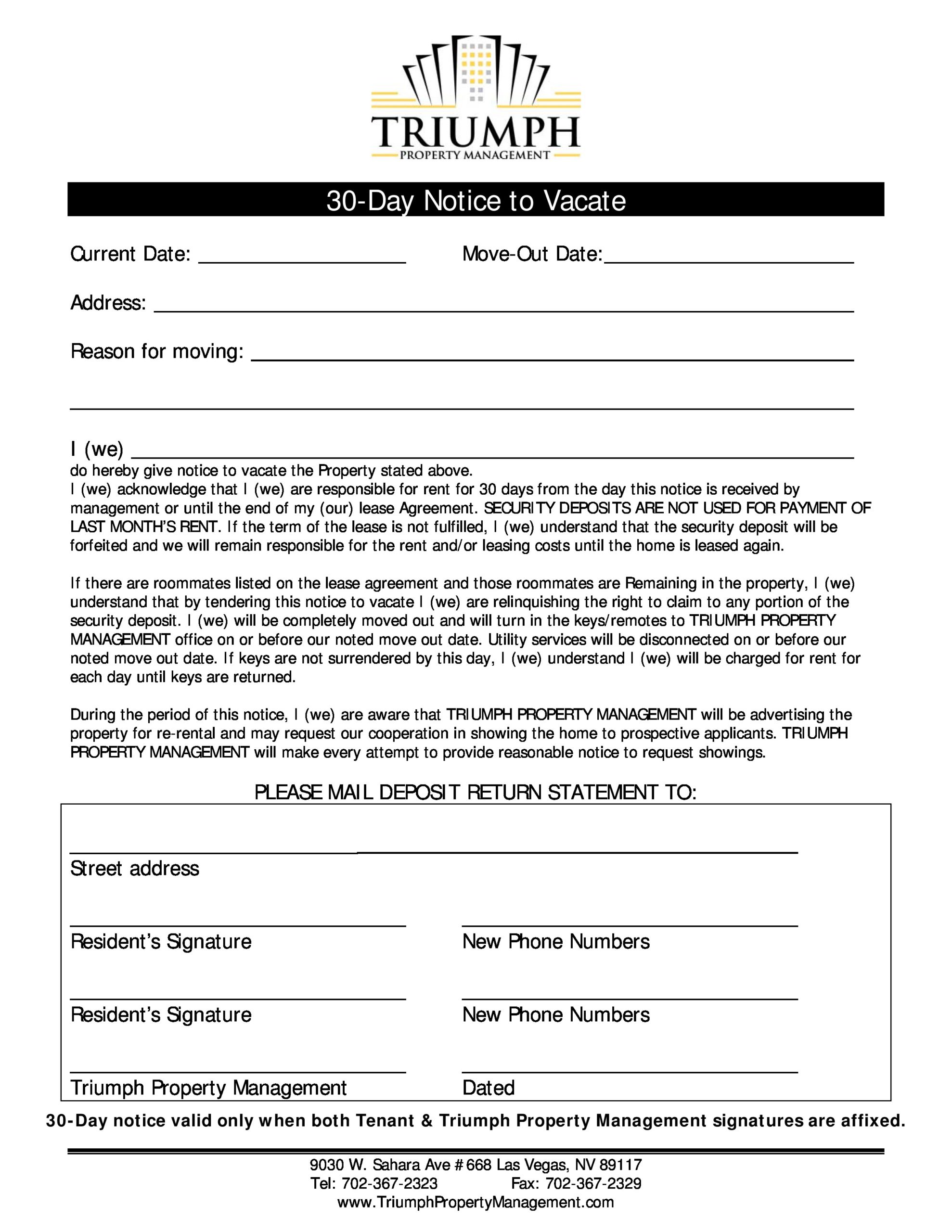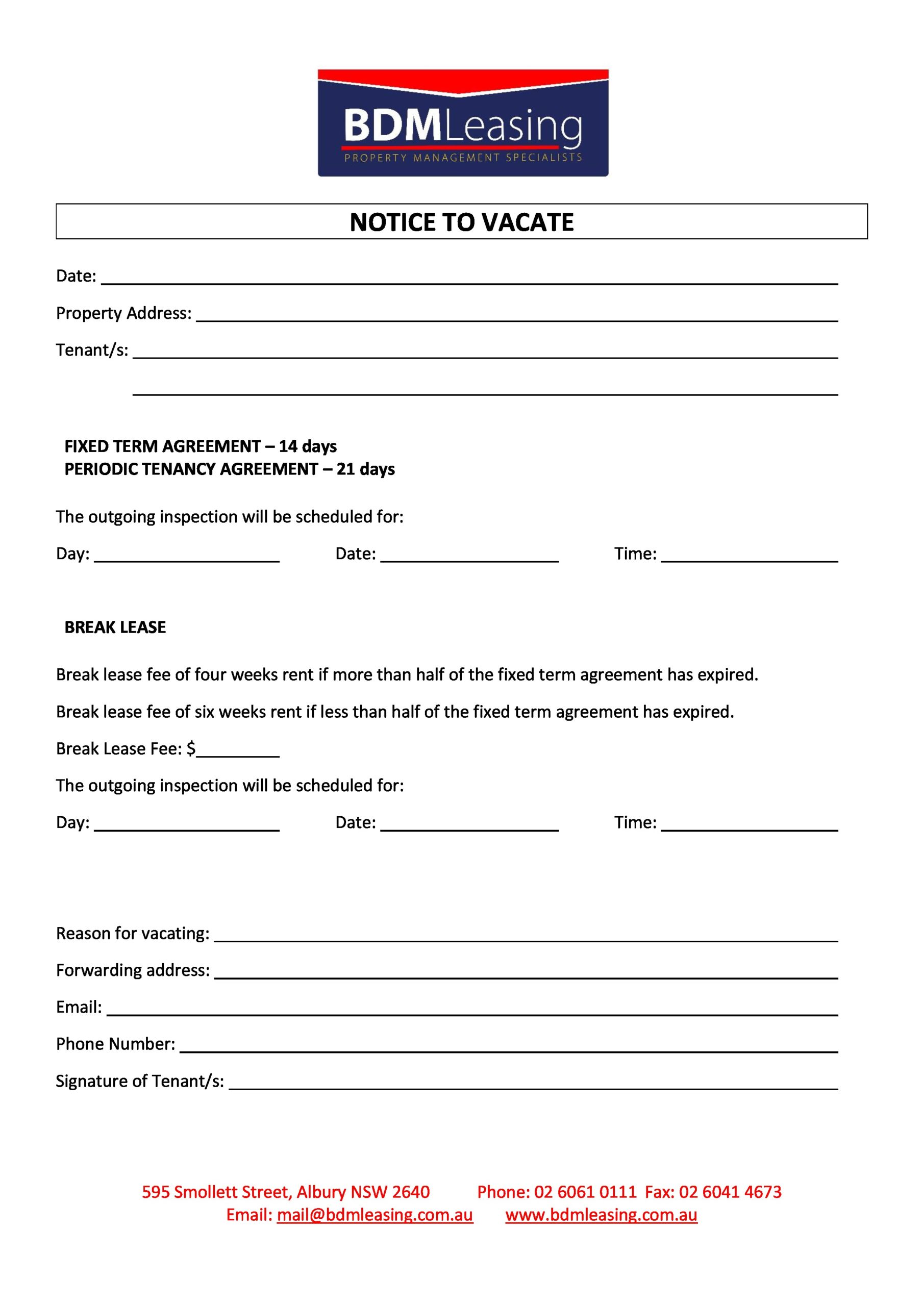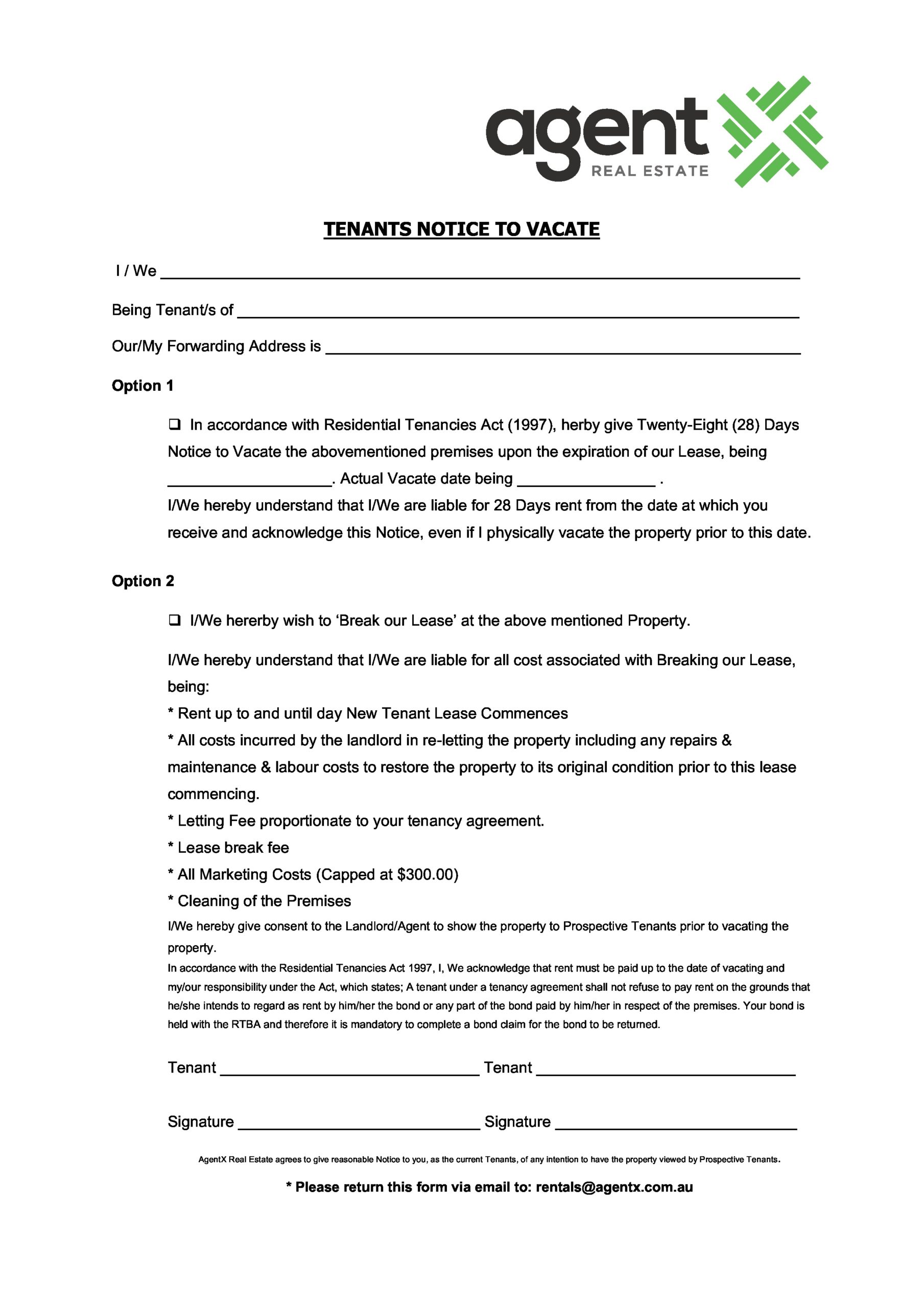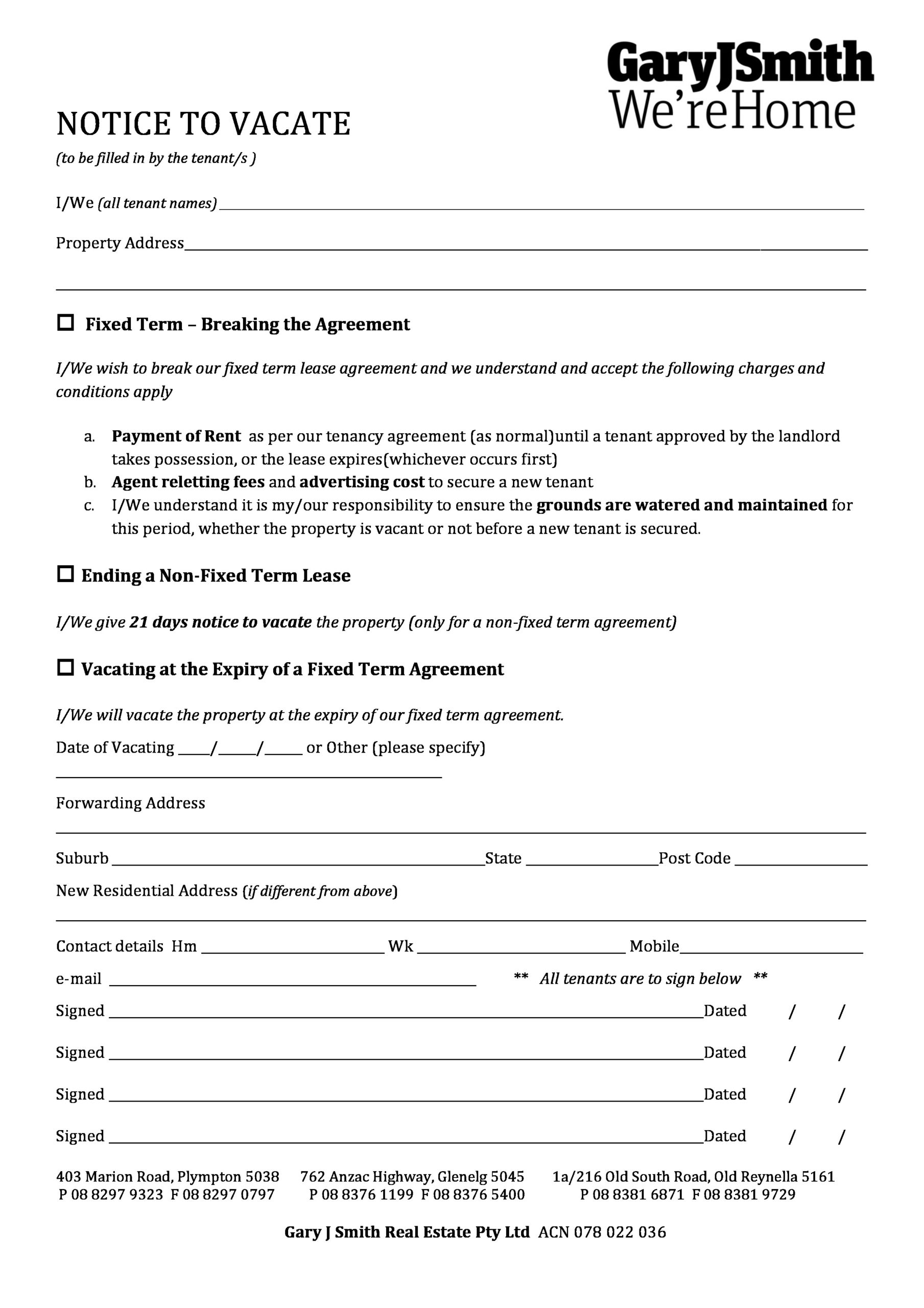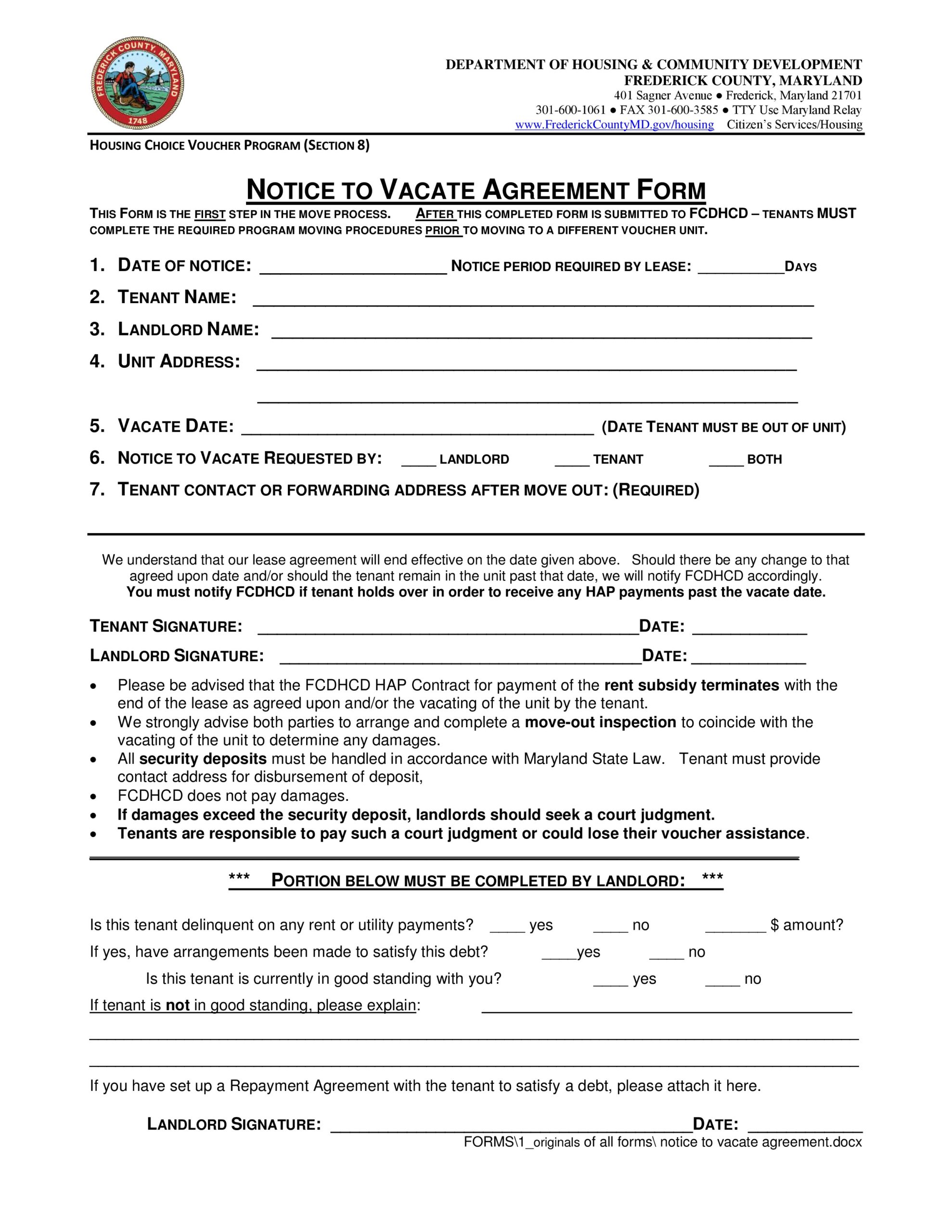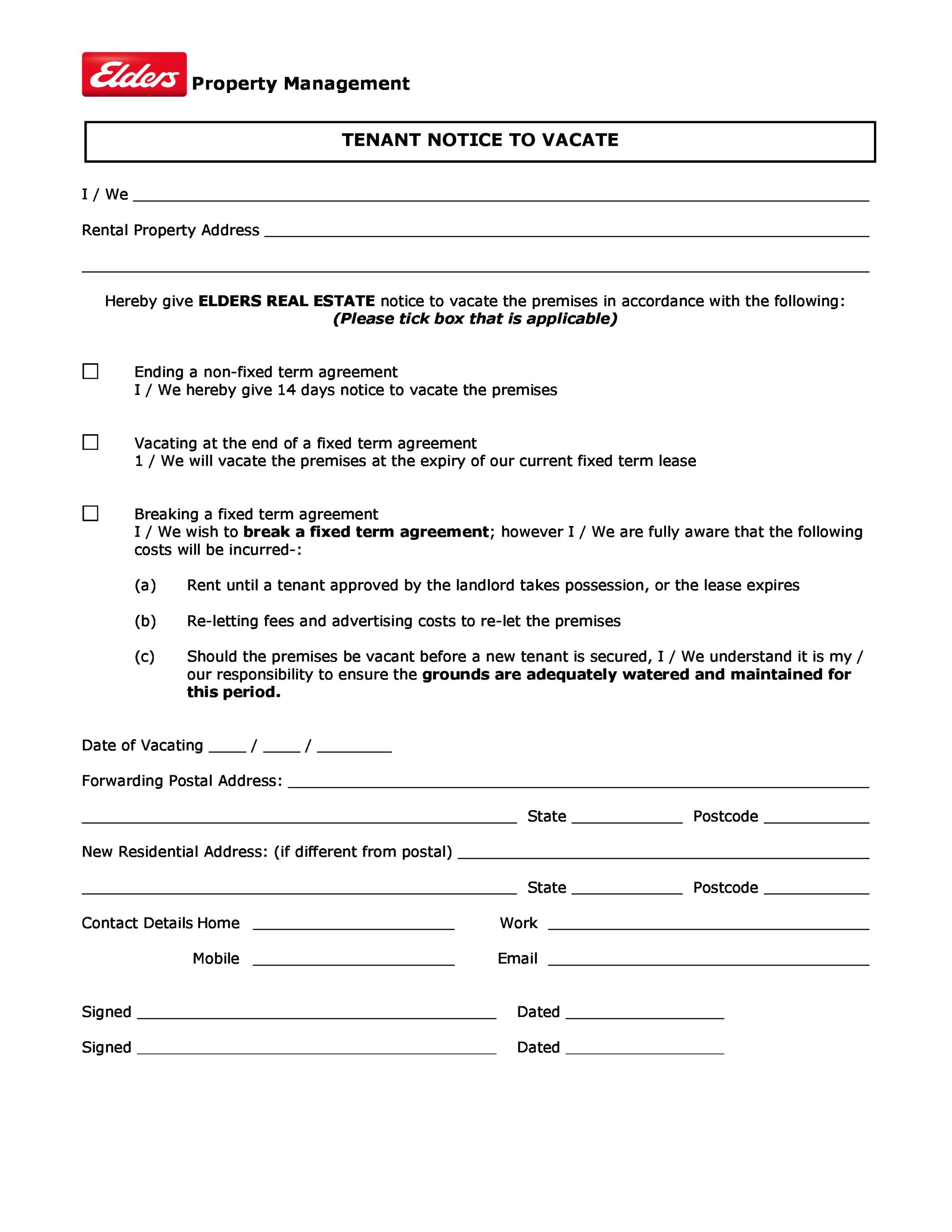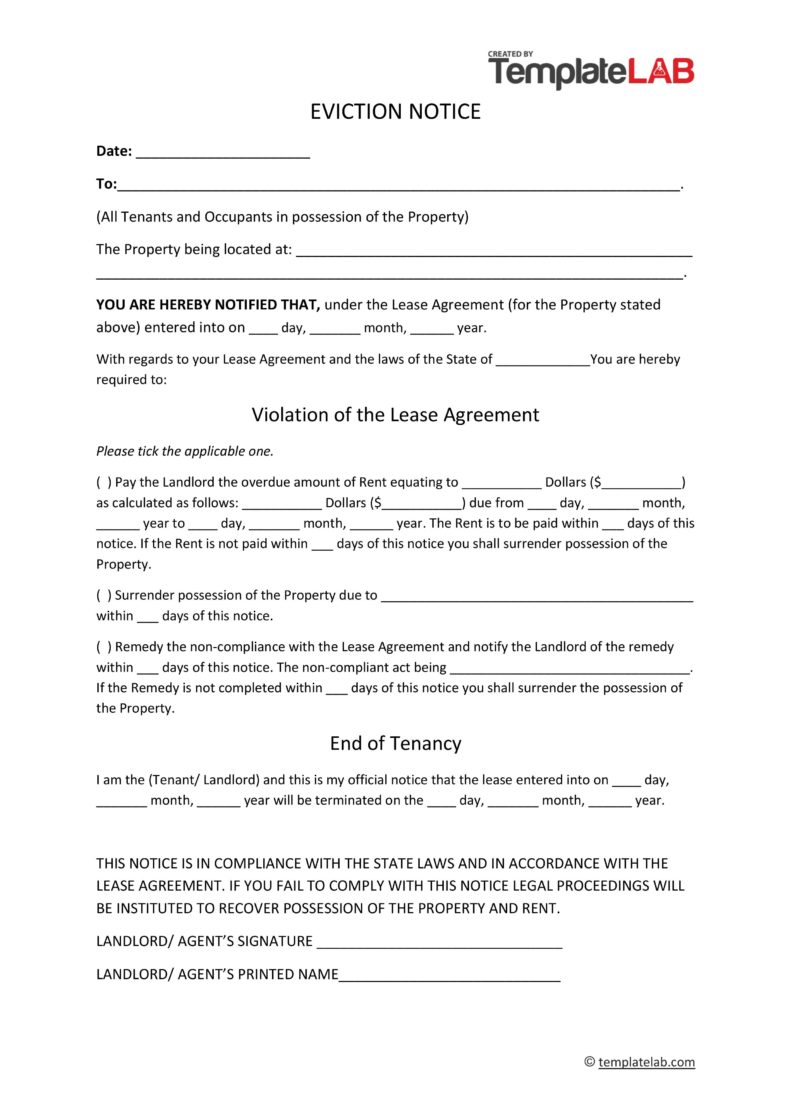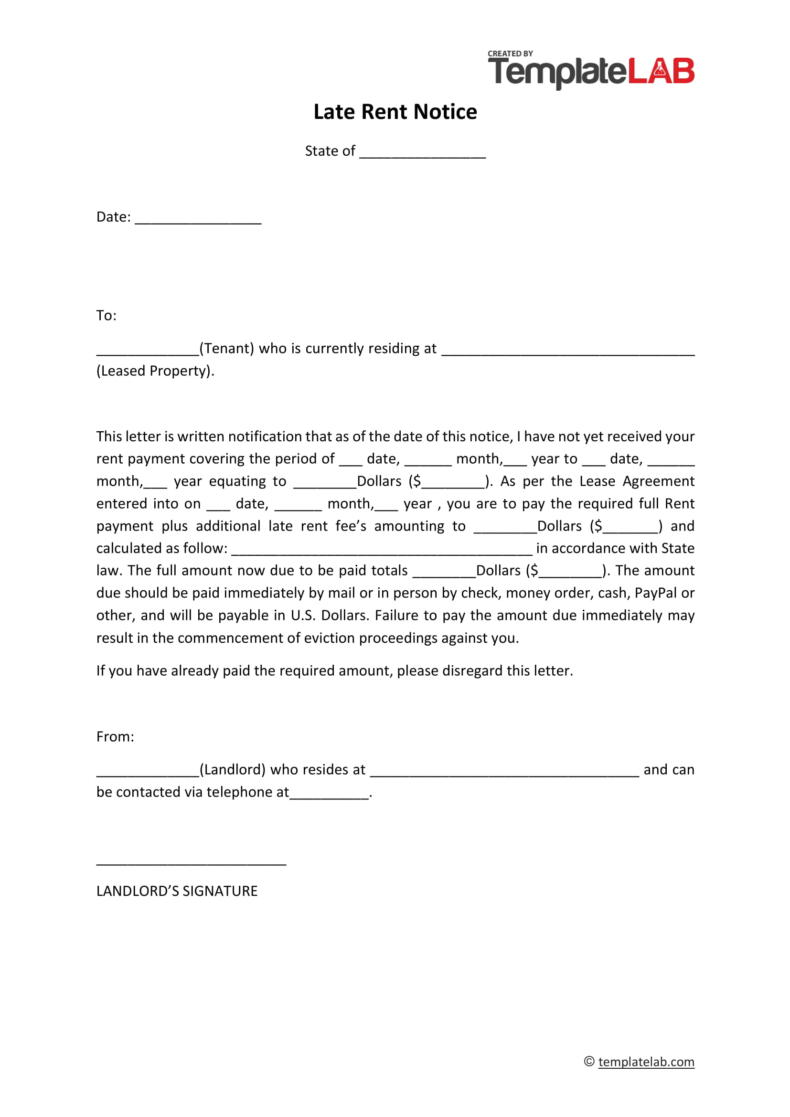If you rent a property of any kind, you will need to know how to write a notice to vacate letter. The notice to vacate form is used in all forms of renting to notify the landlord when you plan to move out for one reason or another. This is a legal document that is sent to the landlord with a set of notice considered before you vacate the premises.
In many states, a 30-day notice to vacate is used for this process, but the time frame for moving out might be different where you live. You will want to verify what the notice period is in the state that you reside in before you assume that you can move out after 30 days of notice have been given.
Table of Contents
- 1 Notices to Vacate Templates
- 2 What is a notice to vacate?
- 3 Notices to Vacate Letters
- 4 What to include in a notice to vacate?
- 5 Notice To Vacate Forms
- 6 How to write a notice to vacate
- 7 Landlord Notice To Vacate
- 8 Keep a copy of the move-out notice letter
- 9 Tenant Notice To Vacate
- 10 Notice to Vacate Letters Are Important For The Rental Process
Notices to Vacate Templates
What is a notice to vacate?
A notice to vacate, or a move-out notice letter, is used by someone who is renting to notify their landlord that they wish to move out of the property in question. There are some other names that this form goes by which do not impact its legal use and do not change the meaning of the form. You can call your notice to vacate by any of these other names without impacting its use in your situation:
- Letter to Vacate Premises
- Notice of Intent to Vacate
- Move-Out Notice
There is no set format that is legally determined for this kind of letter, but you do need to be certain that you have included all the necessary information in your letter for it to be usable. Whether you’re using a 60-day notice to vacate template or a different timeline for your notification, you will just need to be sure that you are clear about the details of the letter before you deliver it to your landlord.
This letter will set in motion moving-out processes which can include an inspection of the property and a final walk-through with the landlord who has been renting to you. Make sure that you are ready to move and live somewhere else if you serve this notice to your landlord because they will typically rent the property again as soon as they know that you will be leaving. Sometimes renters assume that they can get a grace period beyond the 30 or 60 days that are provided legally in their state, and this can lead to problems if the property has already been rented again.
Notices to Vacate Letters
What to include in a notice to vacate?
There’s some basic information that needs to be included in every notice to vacate. Knowing what to put in your letter is important so that it can be useful to you and can clear up any confusion that you might have with your landlord about your moving-out date. The following information needs to be included in your notice to vacate:
- Date that you will vacate
- Date the letter was sent
- Landlord’s address and contact information
- Final walkthrough request
- Lease clauses
- Forwarding address
Notice To Vacate Forms
How to write a notice to vacate
- Date That You Will Move Out. The day that you are planning to move out could be dictated by the 30-day or 60-day notice that is required in your state. While you could choose to move out before these days have elapsed, you will still be responsible for paying rent up to the end state of your time as residents in the property in question. You will want to check the details of your lease before you assume that you can just pick a move-out date of any kind that suits your plans. When you are not renting month-to-month, you may not be able to move out before the end of your lease period as contracted with the landlord.
If subletting is not allowed for your lease contract, you may be forced to wait until the end of your lease to be able to serve notice that you want to move out. Many annual leases afford renters a discount for the monthly rental rate, and there are other perks that are often associated with choosing to rent for an entire year at a time. While you might be able to break your lease early, it is very rare to be able to end a yearly lease ahead of the final date that is listed in the leasing agreement.
Typically the only time that this is possible is when the landlord has taken some action against you that is not allowed for the leasing contract or when your circumstances have changed, and you have suffered a financial hardship that makes you unable to continue to rent the property at the stated rate. The rules for breaking a lease early vary per state, so you need to look at what the guidelines are for your state of residence before you decide to try to break your lease early. - Date the Letter Was Sent. The date that the letter was sent must be included in the documentation so that both you and the landlord are aware of when you gave notice of your intention to move out of the property. It is always wise to consider sending this kind of letter by certified mail so that you are certain that it has been received by your landlord. You can also elect to deliver this letter in person to the renting office or to the landlord’s address to be certain that it has been received and that they are aware of your intentions to vacate the premises.
When an enforced 30 or 60-day notice is required to end a rental contract, the date of the letter becomes the start date of the notice process for these 30 or 60 days that must be observed by both parties. - Landlord Information. In this section of the document, you will need to indicate the landlord’s full legal name as well as their address and their phone number. If you’re renting from a rental company you will need to use the full legal name of the rental company for this part of the document. Nicknames or incorrect names for businesses can lead to problems with the letter’s use. The information for your landlord should be on your lease documents if you’re uncertain about the details of their contact information or their legal address.
In some cases, you’ll be serving notice to a property management company that is not actually the owner of the property. If this is the case, we will simply indicate the property management company in this part of the document with their full address and also with their contact information. - Walkthrough Request. No rental contract can be finalized and ended without a final walk-through request being taken and completed. This final walk-through ensures that you get back your deposit if the apartment is left in the condition that was requested by the rental company or landlord for your move-out date. Many landlords and renting agencies will require some form of preparation for your move-out date that will be laid out in your original rental agreement.
Make sure that you do not forget to take care of this important step, or you might suffer consequences that you would rather avoid that could delay your ability to move out of the apartment or property. And it’s always easiest to be sure that all of your possessions are out of the property before the walk-through so that the inspection can be done easily and correctly.
If there are issues with the final walk-through, you will need to speak with your landlord about how to resolve these problems so that you can close out your rental contract with them and move into your new property or residence. - Lease Clauses. In some cases, you’ll need to reference the original lease contract to state your intentions to move out of the property and to verify that you have completed the steps that were requested per your original lease agreement with the landlord. These clauses should be easy to indicate in your notice to vacate, and you should not have to refer to many of the original document’s rules and regulations to complete the notice to vacate. In most cases, this is only necessary if there are some special requirements that need to be made and order for you to move out and end your lease with the landlord.
- Signature. Be sure that you sign and date the document so that it is clear that you are acting in full knowledge of what you are requesting.
- Forwarding Address. You will need to indicate your forwarding address so that you can be reached if there are further issues related to vacating the premises. There should not be anything further that the landlord or rental company that you have been working with should need from you after you have moved out, but providing contact information is always a good idea.
Landlord Notice To Vacate
Keep a copy of the move-out notice letter
Make sure that you do not send the original documents without keeping a copy for yourself. If your notice to vacate should get lost in the mail, there should be issues with a certified letter that you have sent. You will want to have a copy to prove that you did intend to send the letter to your landlord to give them notice that you’re moving out. It can also be a good idea to call your landlord and make sure that they have received this notice to vacate, especially if you’re going to use a 30 or 60-day waiting period before you move out.
Because it can be hard to give notice to your landlord in person if they live out of state or do not reside near your place of residence, you should take precautions to be sure that you are not going to have issues moving out of the property. If there are problems with your landlord with regard to the moving-out process, you will need to be able to point to the effort that you made to notify them that you are ending the lease. Without this kind of proof, you will likely be forced to get an attorney or some form of legal support to try to deal with the landlord or leasing company successfully.
Unfortunately, in some cases, you could still run into issues where the landlord claims that you did not actually serve notice that you planned to vacate the property. Having a copy of your notice to vacate letter as well as proof that you sent it by certified mail can make all the difference if you were dealing with a legal struggle to do with breaking your lease. This notice, as indicated by your letter, will likely be the main way that you can prove that you did attempt to tell your landlord that you planned to move out or end or lease.
Tenant Notice To Vacate
Notice to Vacate Letters Are Important For The Rental Process
If you have never had to write a notice to vacate letter, you will need to be sure that you use this guide to help you draft a letter that is informative and complete. No one wants to have to deal with legal action against the person that they are renting from or confusion about the end of their lease, which could lead to problems moving into a new property or moving out of the area. The better your notice to vacate letter, the more likely it is that you will not have any trouble with ending your lease and moving out.
Always be sure that you check the details of your existing lease and make sure that you are not breaking the terms of the lease or trying to break the lease earlier than you are allowed to do so by the terms of the contract. You can give your landlord a notice to vacate letter that cannot be used if you are not allowed to break your lease early without special circumstances coming into play. Your letter will be most effective if you are aware of the terms of the original lease when you write it.

